Page 185 of 296
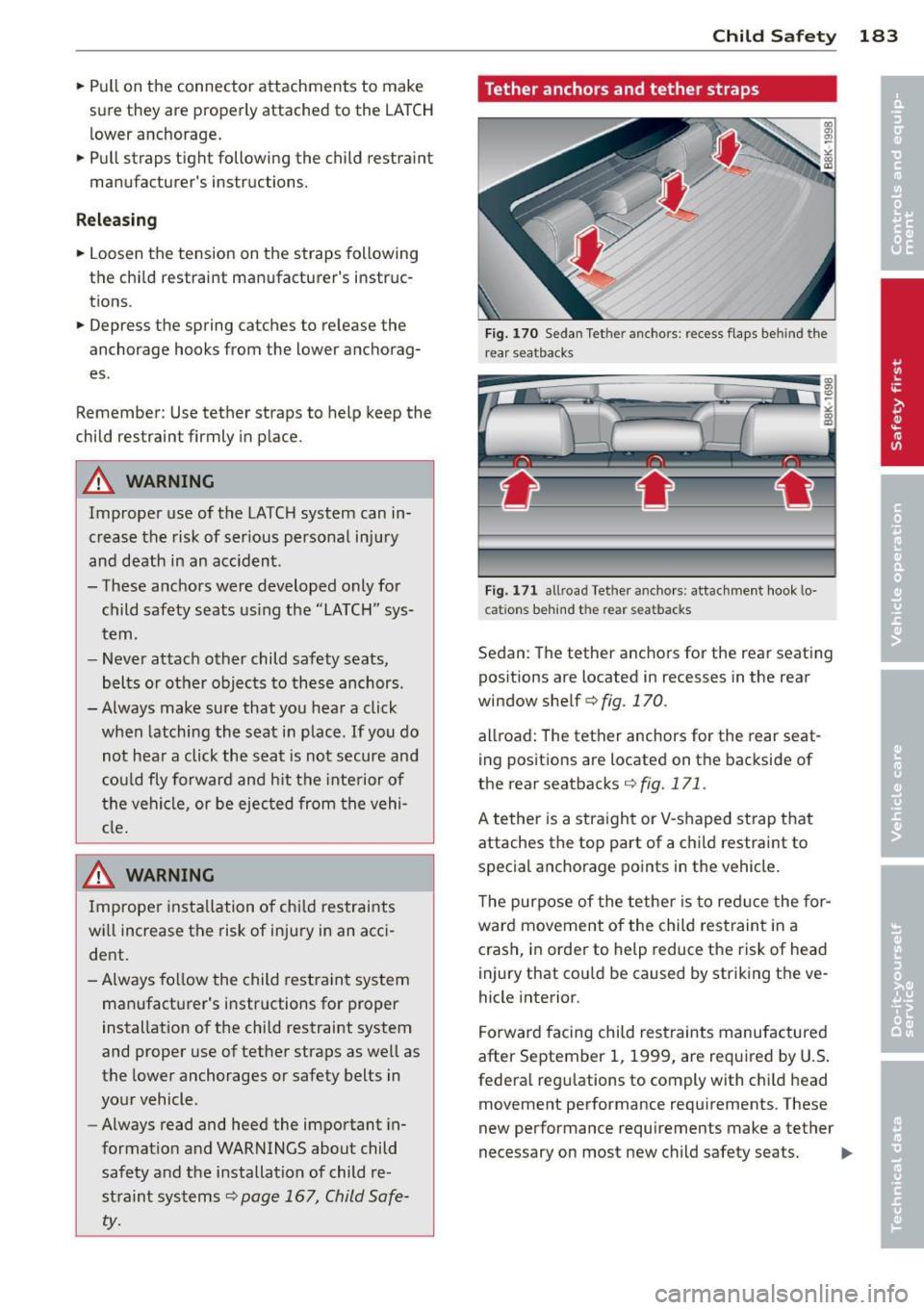
.. Pull on the connector attachments to make
sure they are properly attached to the LATCH
lower anchorage .
.. Pull straps tight following the child restraint
manufacturer's instructions.
R elea sin g
.. Loosen the tension on the straps following
the chi ld restraint manufacturer's instr uc
tions .
.,. Depress the spring catches to release the
anchorage hooks from the lower anchorag
es .
Remember: Use tether straps to help keep the
child restraint firmly in place.
A WARNING
Improper use of the LATC H system can in
crease the risk of ser ious personal injury
and death in an acc ident.
- These anchors were developed only for child safety seats us ing the "LATCH" sys
tem.
- Never attach other child safety seats,
belts or othe r objects to these anchors.
- Always make sure that you hea r a click
when latching the seat in place. If you do not hea r a click the seat is not secure and
c ou ld fly forward and h it the inte rior of
the vehicle, or be ejected from the vehi
cl e.
A WARNING
Improper installation of chi ld restraints
w ill increase the risk of in jury in an acci
dent.
- Always fo llow the child rest raint system
manufacturer's instr uctions for proper
installation o f the child restraint system
and proper use of tether straps as we ll as
the lower anchorages or safety belts in
your vehicle.
-Always read and heed the important in
format io n and WARNINGS about child
safety and the installation of child re
st raint systems~
page 167, Child Safe
ty.
-
Child S afety 183
Tether anchors and tether straps
Fig. 170 Sedan Tether anchors: recess flaps behind the
r ea r seatbacks
Fig. 171 allroad Tether anchors: attac hme nt hook lo
cat io ns be hind the rear seatbacks
Sedan: The tether ancho rs for the rear seating
pos itions are located in recesses in the rear
window shelf
c> fig. 170.
allroad : The tether anchors for the rear seat
ing pos it ions are located on the backside of
the rear seatbacks
c>fig. 171.
A tether is a straight or V-shaped strap t hat
attaches the top part of a ch ild restraint to
special anchorage po ints in the vehicle .
T he purpose of the tethe r is to re duce the for
ward movement of the child rest raint in a
crash, in orde r to help reduce the risk of head
injury that cou ld be caused by striking the ve
hicle interior.
Forward facing child restraints manufactured
after September 1, 1999, are requ ired by U .S .
federal regulations to comply with c hild head
movement performance requirements. These
new performance requirements make a tether
necessary on most new child safety seats. ...,
Page 186 of 296
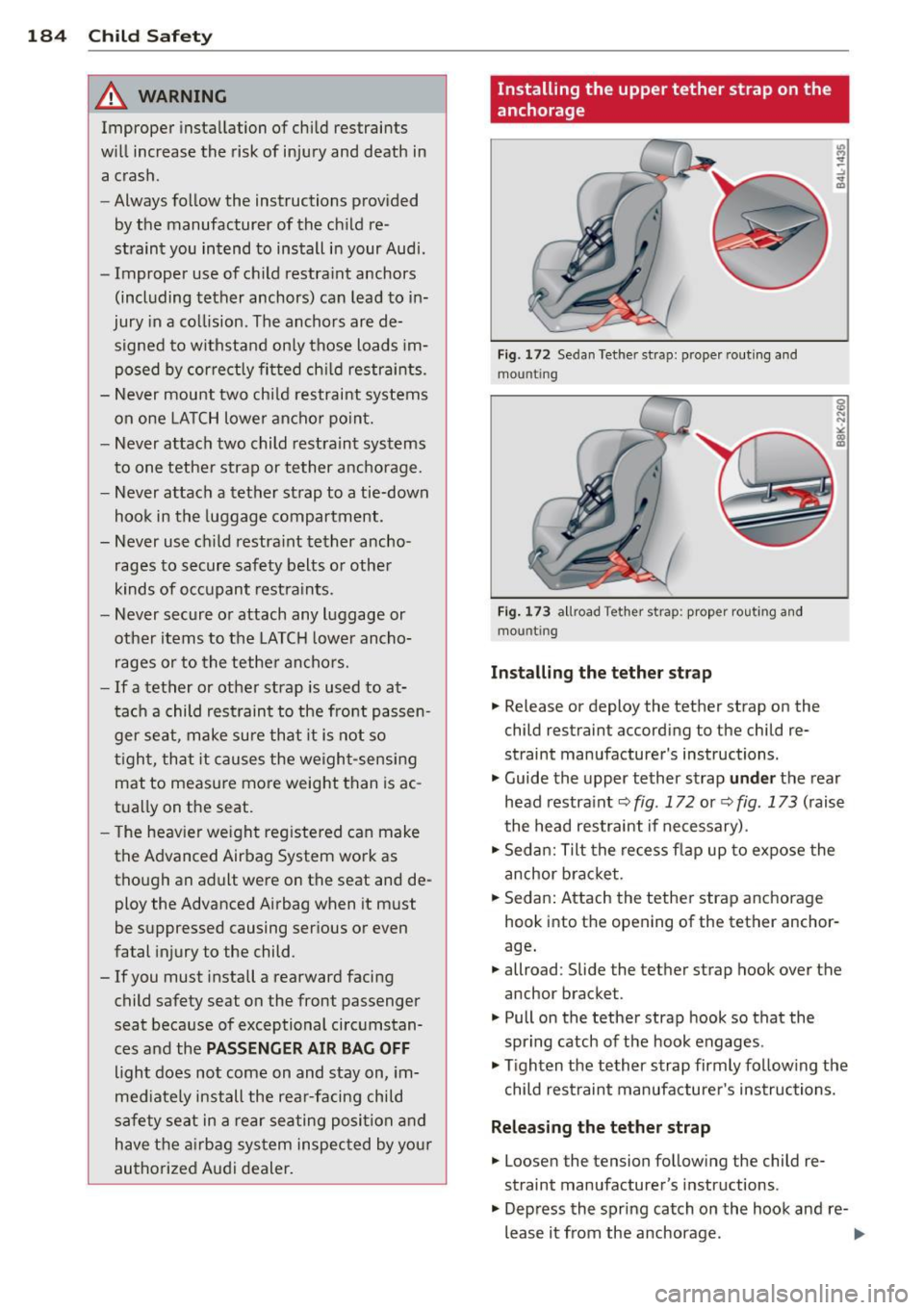
184 Child Safet y
& WARNING
Improper insta llation of child restraints
will increase the risk of injury and death in a crash.
- Always follow the instructions provided
by the manufacturer of the ch ild re
straint you intend to install in your Audi.
- Improper use of child restra int anchors
(including tether anchors) can lead to in
jury in a co llision. The anchors are de
signed to withstand on ly those loads im
posed by correctly fi tted ch ild restraints.
- Never mount two ch ild restraint systems
on one LA TCH lower anchor po int.
- Never attach two child rest ra int systems
to one tethe r strap or tether anchorage.
- Never attach a tether strap to a tie-down
hook in the luggage compartment.
- Never use ch ild restra int te ther ancho
rages to secure safety belts o r other
kinds of oc cupant rest ra ints.
- Never secure o r attach any luggage or
other items to the LATC H lowe r ancho
rages o r to the tethe r ancho rs.
- If a tether or other strap is used to at
tac h a child res traint to the front passen
ger seat, make su re that it is not so
t igh t, that it causes the weight-sensing
mat to measure more weight than is ac
t u ally on the seat.
- T he heav ier weight reg iste red can make
the Advanced Airbag System work as
though an adult were on the seat and de
ploy the Advanced Airbag when it must
be suppressed causing serious or even
fatal injury to the child.
- If you must install a rearward facing
child safety seat on the front passenger
seat because of exceptional circumstan
ces and the
PA SSENGER AIR BAG OFF
light does not come on and stay on, im
med iately install the rea r-facing child
s afety seat in a rear seating posi tion a nd
have the a irbag sys tem inspec ted by yo ur
authorized Audi dealer.
Installing the upper tether strap on the
anchorage
Fig. 172 Sedan Tether strap: prope r ro ut ing and
mount ing
F ig . 1 73 allroad Tether strap: proper routing and
mount ing
Installing the tether st rap
.,. Release or deploy the tether strap on the
child restraint according to the child re
straint manufacturer's instructions .
.,. Guide the upper tether strap
under the rear
head restra int
~fig.172 or¢fig .173 (raise
the head restraint if necessary).
.,. Seda n: Tilt the re cess fl ap up to expose the
a nchor b rac ket.
.,. Sedan: Attach the tethe r strap anchorage
hook into the opening of the tether anchor
age .
.,. allroad : Slide the tether strap hook over the
anchor bracket.
.,. Pull on the tether strap hook so that the
spr ing catch of the hook engages .
.,. Tighten the tether strap firmly fo llow ing the
child res traint manufacture r's ins tructions.
Releasing the tether strap
.,. Loosen the tension follow ing the child re
straint manufacturer's instructions .
.,. Dep ress the spring catch on the hook and re-
lease it from the anchorage. ..,.
Page 187 of 296
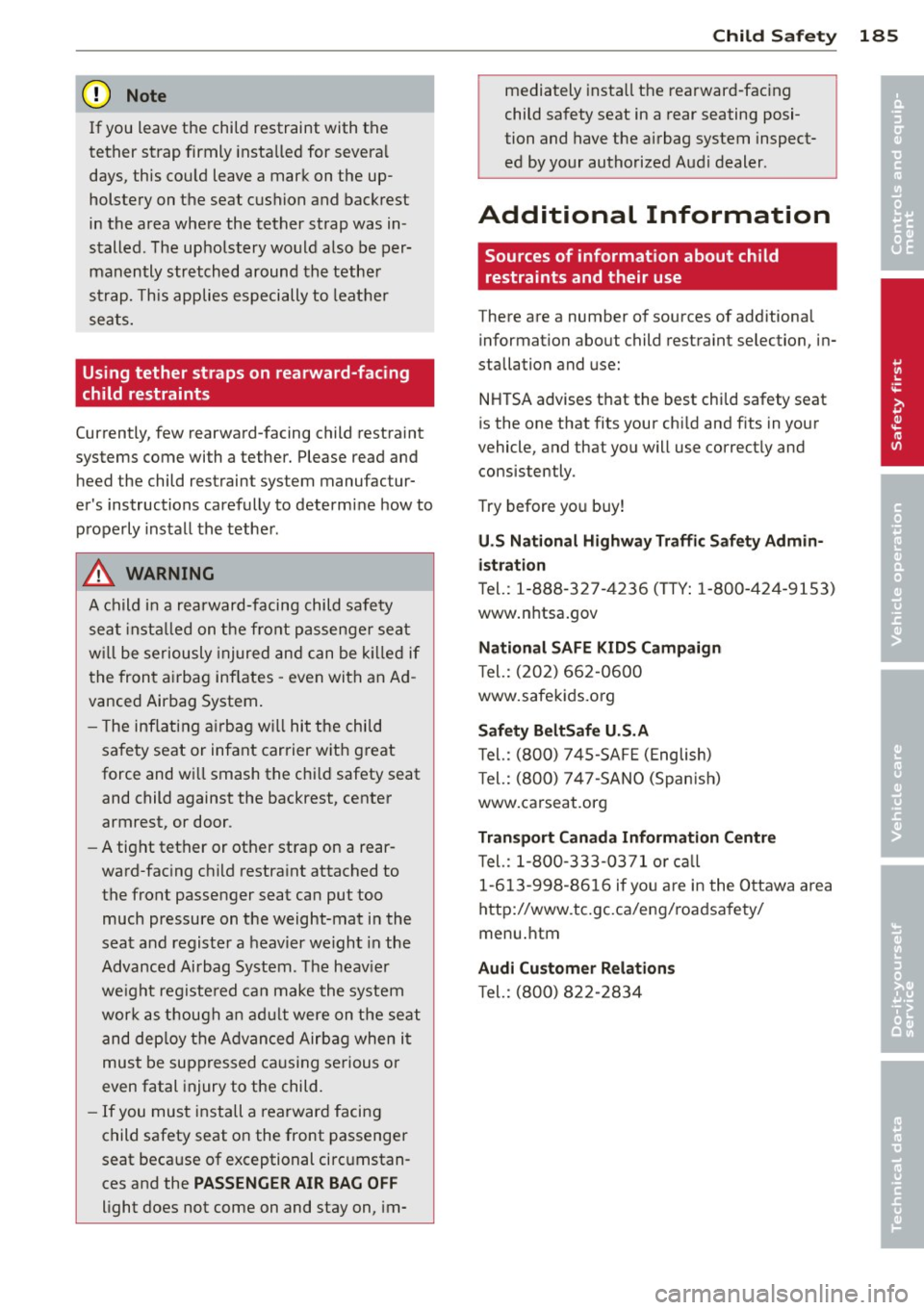
(D Note
If you leave the child restraint with the
tether strap firmly installed for severa l
days, this cou ld leave a mark on the up
holstery on the seat cushion and backrest
in the area where the tether strap was in
s t alled. The upho lstery would a lso be per
manently stretched around the tethe r
s tr ap. This applies especially to leat her
seats.
Using tether straps on rearward-facing
child restraints
Currently, few rearward-facing child restraint
systems come with a tether. Please read and h eed the child restraint system manufactur
er's instructions carefully to determ ine how to
p roperly install the tethe r.
A WARNING
-
A ch ild i n a rearward-facing child safety
s ea t insta lled on the front passenger sea t
w ill be seriously injured and can be killed if
t he fron t air bag inflates -even with an Ad
vanced Airbag System .
- T he inflating a irbag w ill hit the chi ld
sa fety seat or infa nt carrier w it h great
force and wi ll smash the ch ild safety seat
and child against the backrest, center
armrest, or door.
- A tight tether or other strap on a rear
ward-fac ing c hild restra int attached to
the front passenger seat can put too much pressure on the weight-mat in the
sea t and regis ter a heavier we igh t in the
Advanced Airbag System. The heav ie r
we ight registe red ca n make the system
wor k as th ough an adul t were on t he seat
and dep loy the A dvanced Airbag when i t
must be supp ressed ca using serious or
even fatal injury to the child.
- If you mus t insta ll a rearward facing
child safety seat o n the front passenger
seat beca use of exceptional circ umstan
ces and the
PASSENGER AIR BAG OFF
light does not come on and stay on, im-
Child Sa fet y 185
mediately insta ll th e rearward-fac ing
child safety seat in a rear seating posi
tion and have the airbag system inspect
ed by your authorized Audi dealer .
Additional Information
Sources of information about child
restraints and their use
There are a number of sources of additional
information about child restraint se lection, in
stallation and use:
NH TSA advises that the best chi ld safety seat
is the one that fits your chi ld and fits in your
vehicle, and that you w ill use correct ly and
consistently.
T ry before yo u buy!
U .S National Highway Traffi c Safety Admin
istration
Tel.: 1 -888 -3 27- 42 36 (TIY: 1-800 -42 4-9153)
www.n htsa.gov
National SAFE KIDS Campaign
Tel.: (2 02) 662- 0600
www.safe kids.o rg
Safety BeltSafe U .S .A
T el.: (8 00) 7 45-SAF E (English)
T el.: (8 00) 747 -SANO (Span ish)
www.carseat.org
Transport Canada Information C entr e
Tel.: 1 -800 -333-0371 or c all
1-6 13-99 8-8616 if yo u are in the Ottawa area
http://www.tc.gc.ca/eng/ roadsa fety/
menu .htm
Audi Cu stomer Relation s
Tel.: (800) 822-2834
•
•
Page 188 of 296

186 Intelligent technology
Intelligent technology
Notice about data
recorded by vehicle
control modules
Your veh icle is not equipped with an Event Da
ta Recorde r (EDR), ins talled by some manu
facture rs fo r the express p urpose of capturing
data for retrieval after an accident or cras h
event . EDR's are sometimes ca lled "crash re
corders".
Some state laws restr ict the retr ieval or down
loading of data stored by EDR's that were in
stalled in a vehicle for the express purpose of retrieving data after an accident or crash
event without the owner's consent.
A ltho ugh yo ur vehicle is not equ ipped wit h an
EDR, it is equipped with a number of electron
ic control modules for various vehicle systems
such as, for examp le, eng ine f unction, em is
sion control, as well as for the airbags and
safety belts.
These electronic contro l modules also record
vehicle-re lated data during norma l vehicle op
erat ion for diagnostic and repa ir purposes.
The recording capacity of the electronic con
trol modules is limited to data (no sound is re
corded) and only a small amount of data is ac
tually recorded ove r a ve ry limited pe riod of
time and stored when a sys tem faul t or o ther
cond ition is sensed by a cont ro l u nit. Some of
the data then stored may re late to vehicle
speed, direction, braking as we ll as restraint
system use and performance in the event of a
crash or other condit ion. Stored data can only
be read and downloaded w ith special equip
ment.
Electronic Stabilization
Control (ESC)
Description
ESC helps to improve road holding and vehicle
dynamics to help reduce the probability of
skidd ing and loss of ve hicle control. It works
only when the eng ine is running. ESC detects certain difficult driving situat
ions, including
when the vehicle is beginning to spin (yaw)
o ut of control and he lps you to get the veh icle
back under control by se lectively braking the
whee ls, and/or reducing eng ine power and
providing steer ing ass istance to he lp hold the
vehicle o n the dr iver's intended course. The in
dicator light
J.i) in the instrument cluster
blinks when ESC is ta king action to help yo u
control the veh icle.
ESC has limitations.
It is importa nt to remem
ber that ESC cannot overcome the laws of
physics. It will not always be able to help out
under a ll cond it ions you may come up aga inst.
F or example, ESC may not always be able to
help you master situations where there is a
s u dden change in the coefficient of friction of
the road surface. When there is a section of dry road that is sudden ly covered w ith water,
s lush or snow, ESC cannot perform the same
way it wou ld on the dry surface . If the ve hicle
hydroplanes (rides on a cushion of water in
stead of the road surface), ESC will not be
able to help you steer the vehicle be cause con
tact with the pavement has been in terrupted
and the vehicle cannot be braked or steered .
D uring fast cornering, particularly on winding
roads, ESC cannot always deal as effectively
with difficult driving situations than at lower
speeds. When towing a trailer, ESC is not able
to help you regain control as it would if you
were not tow ing a trailer.
Always adjust your speed and driving style to road, traffic and weather condit ions. ESC can
not override the vehicle's physical limits, in
crease the availab le tract ion, or keep a ve hicle
on the road if road departure is a result of
driver inattent io n. Instead, ESC imp roves the
poss ibil ity of keeping the vehi cle under con
trol and on the road during extreme maneu
vers by using the d river's steering inputs to
help keep the vehicle going in the intended di
rection . If you are traveling at a speed that
ca uses you to run off the road before ESC can
provide any assistance, you may not experi
ence the benefits of ESC.
Page 189 of 296

ESC includes and/or works together with the
anti-lock brake system (ABS), brake assist sys
tem, anti -slip regulation (ASR) , e lectronic dif
ferential lock (EDL), dynamic steering* and electronic i nteraxle differential lock* /selective
wheel torque control* . ESC is switched on all
the t ime. I n certain s ituations when you need
less traction, you can switch
off ASR by press
i ng the button~~
page 188, fig. 174 or
~ page 188, fig. 175. Be sure to sw itch ASR
on again when you no longer need less trac
tion.
Anti-lock b ra king s ystem (ABS)
ABS prevents the wheels from locking up
when braking. The vehicle can still be steered
even d uring hard brak ing . Apply ste ady p res
sure to the brake pedal. Do not pump the ped
a l. A pulsing in the brake peda l indicates t hat
the system is he lping you to brake the vehicle .
Brake assist system
The brake assist system can decrease bra king
d istance. It increases braking power when the
d river presses the brake pedal quick ly in eme r
gency situations . You must press and hold the
brake peda l until the situation is over. In
veh icles w ith adaptive cru ise contro l*, the
brake assist system is more sensit ive if the
d istance detected to the veh icle ahead is too
small.
Anti- slip regulati on (ASR)
ASR reduces engine power when the drive
wheels begin to spin and adapts the force to
the road condit ions. This makes it eas ier to
start, accelerate and drive up hills.
Elect ronic diffe renti al lo ck (EDL )
The ED L brakes wheels that are spinning and
transfers the drive power to the other drive
wheel or wheels if the vehicle is equipped with
all-wheel drive*. This function is available up
to about 60 mph (100 km/h) .
In extreme cases, EDL automatica lly switches
off to help keep the brake on the braked whee l
from overheating. EDL w ill switch on again au-
Intellig ent technolog y 187
tomat ica lly when conditions have returned to
norma l.
Dynamic steering*
On vehicles with dynam ic steering*, ESC helps
stab il ize the s teer ing in crit ica l sit uat io ns.
Electronic interaxle differential lock* /
selective wheel torque control*
T he electronic i nteraxle differential lock (front
whee l dr ive) or the se lective whee l to rque
control (all-whee l dr ive) opera tes when dr iv
ing thro ugh curves. The front wheel on the in
side of the c urve or both whee ls on the inside
of the curve are braked selectively as needed .
This min imizes sliding in the front wheels and
allows for more precise driving through
cu rves . The applicable system may not acti
vate when dr iv ing in wet or snowy conditions.
A WARNING
- ESC, ABS , ASR, EDL dynam ic steering*
a nd the elect ronic interaxle differential
loc k* /se lective wheel torque control*
cannot overcome the laws of physics .
This is especially important on slippery
or wet roads. If the systems begin acting
to stabilize your veh icle, yo u should im
mediately change your speed to match
the road and traff ic conditions. Do not
let the increased safety provided by
these systems tempt you to take r isks.
Doing so will increase the risk of a loss of
veh icle contro l, col lision and ser ious per
sonal injuries.
- Always adapt your speed to road, traffi c
and wea ther conditions. The risk of los
ing con tro l of the vehicle increases when
driving too fast, espec ially through
curves and on slippery or wet roads, and
when dr iv ing too close to vehicles up
ahead. ESC, ABS, the brake ass ist sys
tem, ASR, EDL dynam ic steering* and the
electronic interaxle differentia l lock*/se
lective whee l torque control* cannot p re-
vent co llisions . ..,.
•
•
Page 190 of 296

188 Intelligent technology
-Always accelerate with special care on
even, smooth surfaces such as those that
are wet or covered with ice and snow.
The drive wheels can spin even with
these assistance systems that cannot al
ways help to reduce the risk of loss of ve hicle control.
(i_) Tips
-ABS and ASR only work correctly when
all four wheels are equipped with identi-
Switching on/off
cal tires. Different tire sizes can lead to a
reduction in engine power.
- You may hear noises when the systems
described are working.
- If the indicator light
bl or t!lJ (USA
models)/[IJ (Canada models) appears,
there may be a malfunction
¢page 18,
¢page 19.
ESC turns on automatically when you start the engine.
Fig. 174 Version A: lower center console,~ OFF but·
ton
The ESC is designed to function in levels. De
pending on the level that is selected, the sta
bilization function of the ESC is limited or
switched off. The amount of stabilization con
trol will differ depending on the level.
The following situations are exceptions where
it may be useful to switch on sport mode (Se
dan) or offroad mode (allroad) to allow the
wheels to spin:
Fig. 175 Version B: upper center console,~ OFF but·
to n
-Rocking the vehicle to free it when it is stuck
- Driving in deep snow or on loose ground
- Driving with snow chains
- allroad: Driving on rough terrain when much
of the car's weight is lifted off the wheels
(axle articulation)
- allroad: Driving downhill while braking on
loose ground
Page 191 of 296
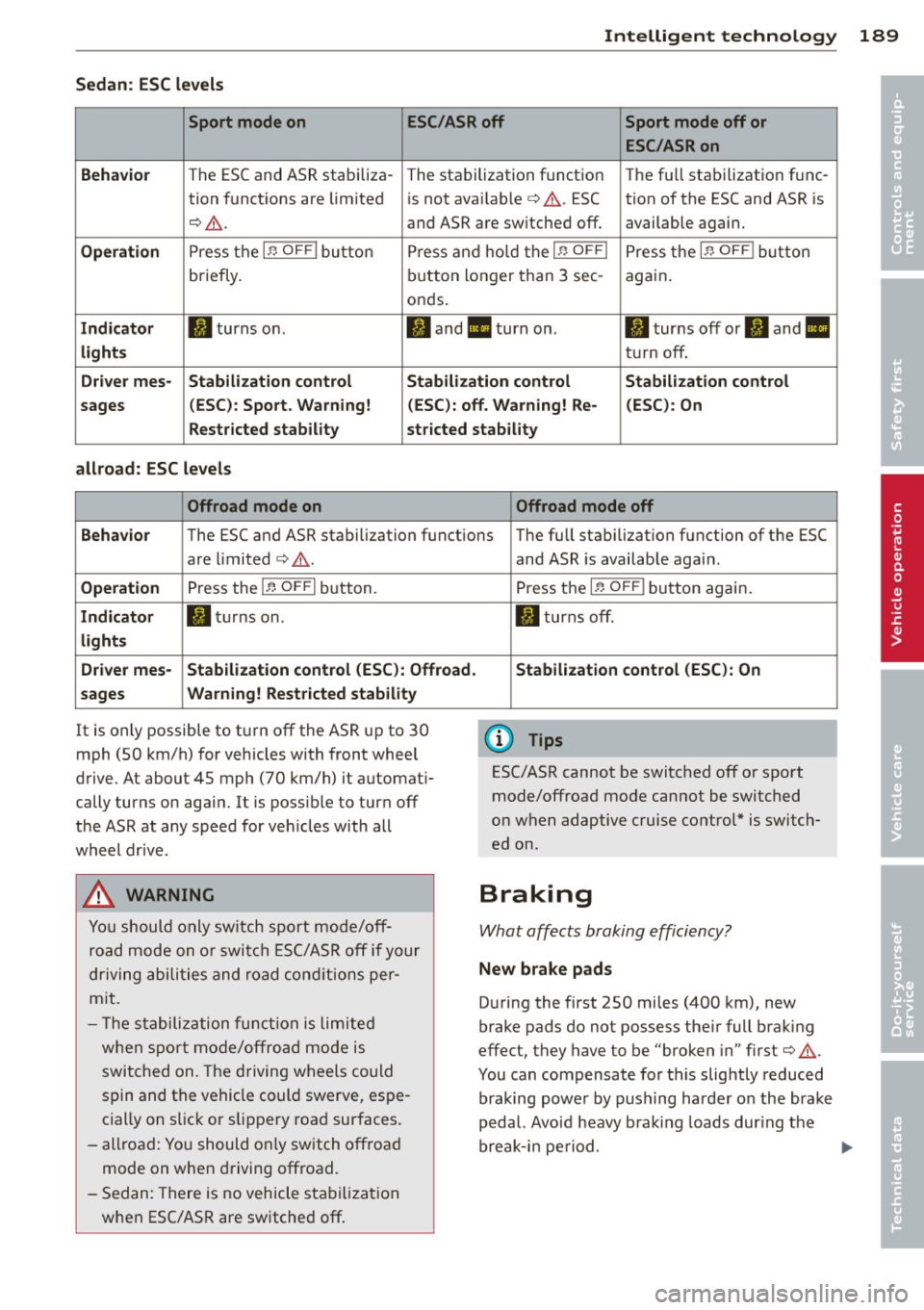
Intelligent technology 189
Sedan: ESC levels
Sport mode on ESC/ASR off Sport mode off or
ESC /ASR on
Behavior
The ESC and ASR stabiliza- The stalbilization f unct ion The fu ll sta bilization f unc-
tion funct ions are lim ited is not ava ilable
c:> A . ESC tion of the ESC and ASR is
c:, A . and ASR are sw itched off. available agai n.
Operation Press t he I~ OFF I button Pre ss and h old t he I~ OFFI Press t he i.i, OF FI bu tton
briefly. bu
tton longer than 3 sec -
aga in .
o nd s.
Indicator II turns on. II an d II turn on . II turns off or fl and II
lights tur n off.
Driv er mes· Stabilization control Stabilization control Stabilization control
sages (
ESC) : Sport . Warning! (ESC): off . Warning! Re- (ESC) : On
Restricted stability stricted stability
allroad: ESC level s
Offroad mode on Offroad mode off
Behavior
The ESC and ASR stabilization funct ions T he full stab ilizat ion function of the ESC
are limited
c:> A .
Operation Press the I~ OFFI bu tton.
Indicator II tur ns on.
light s
D river mes- Stabilization control (ESC ): Offroad.
sages Warning! Rest
ricted stability
It is on ly possible to t urn off the AS R up to 30
mph (SO km/h) f or veh icles with front whee l
drive. At about
45 mph (70 km/h) it a utomat i
cally turns on aga in. It is poss ible to turn off
the ASR at any speed for veh icles with all
wheel dr ive .
A WARNING
-
Yo u should o nly sw itch sport mode/off
r oa d m ode on or swi tch E SC/A SR off if your
d rivi ng abili ties a nd ro ad con ditio ns per
m it .
- T he stabili zation fu nction is limited
w he n sp ort m od e/off road mode is
switched on . The driving w heels could
s p in and t he vehicle c ould swerve, es pe
c ia lly on s lick or slipp ery roa d sur faces .
- all road: Yo u should o nly sw itc h off roa d
mode on when driving offroad .
- S edan: There is no vehicle sta biliz atio n
w hen ESC/AS R are switched off . and ASR
is availab le aga in.
Press t he
I~ OFF I button again .
II turns off.
Stabilization control (ESC ): On
(D Tips
ESC/ASR cannot be switched off o r sp o rt
mode/offroad mode ca nnot be switched
on when adaptive cruise control * is switch
ed o n.
Braking
What affects braking effic iency?
New brake pads
D uring the first 250 mi les (4 00 km), new
brake pads do not possess the ir full brak ing
effect, they have t o be "broken in" first
c:> A .
You can compensate for this slightly reduce d
braking powe r by pushing har der on the brake
p edal. Avo id heavy b ra ki ng loa ds dur ing t he
break-i n pe riod.
•
•
Page 192 of 296

190 Intelligent technology
Operating conditions and d riving hab it s
The brakes on today 's automob iles are st ill
subject to wear, depending largely on operat
ing conditions and driving habits
c::> ,& . On
vehicles that are either driven mostly in stop
and-go city traffic or are driven hard, the
brake pads should be checked by your author
ized Audi dealer more often than specified in
the
W arranty & M ainte nance booklet . Failure
to have your brake pads inspected can result
in reduced b rake pe rformance.
On steep slopes, you should use the brak ing
effect of the eng ine . This way, you prevent un
necessa ry wear on the brake system. If you
must use you r brakes, do not hold the brakes
down continuously . P u mp the b rakes at inter
va ls.
Operating nois e
Noises may occur when braking depending on
the speed, braking force and outside condi
tions such as temperature and humidity .
Effect of w ater and ro ad sa lt
In certain situat ions, for example after driving
through wate r, in heavy ra in, after overn ight
condensation or after washing your car, the brak ing effect can be reduced by moistu re or
i ce on the bra ke roto rs and b rake pads . The
b rakes must be dried fi rst with a few ca ref ul
brake app lications .
At h igher speeds and with the w indshie ld w ip
e rs turned on, the brake pads press agains t
the bra ke rotors for a short amount of time.
This occurs a t regular intervals without the
driver noticing and provides for better brake response time under wet conditions.
The effectiveness of the brakes can be reduced
when the vehicle is driven on a salt-covered
road and the brakes are not used. Likewise,
you clean off accumulated sa lt coating from
brake discs and pads with a few caut ious ap
plications of the brake
c::> ,& .
Cor rosion
There may be a tendency for dirt to bui ld up
on the brake pads and corrosion to form on the d
iscs if the car is not driven regu larly or
o n Ly for short trips with litt le use of the
brakes.
If t he brakes a re not used frequently, o r if cor
r os ion has formed on the discs, it is adv isable
to clean off the pads and discs by braking
firmly a few times from a moderately h igh
speed
c::> .&. .
Fault s in the brak e syst em
If you shou ld notice a sudden increase in
brake pedal trave l, then one of the two brake
circuits may have fai led
c::> .& .
Low br ake fluid lev el
Malfunctions ca n occu r in the b ra ke system if
t h e b rake fluid level is too low. The brake flu id
l evel is monitored electronica lly.
Brake booster
The brake booster inc reases the pressure that
you generate with the b rake peda l. It works
o n ly when the engine is runn ing
.c::> .&
Brake lining wear status
Brake lining wear may be checked by visual in
spect io n of the condition of the brake pads
th rough the open ings in the wheel. If neces
sary, the wheel may be removed fo r thi s i n
spe ct ion
c::> page 255, Changing a wheel.
.&, WARNING
- New b rake pads don' t have the bes t stop
ping power and m ust be "bro ken -in" dur
ing the initial 100 to 150 miles (150 to
200 kilometers) of normal c ity driving.
You can compensate for this by pressing the brake pedal more firmly. Th is also
applies later when new pads are instal
led.
- You shou ld perform braking maneuvers
for the purpose of cleaning the brake
system only if road conditions permit.
Othe r road use rs must no t be put at risk -
you may ca use an accident!
- Before descend ing a steep grade, reduce
speed and sh ift transmission into a lower
gear or lower dr iving range. Do not ride
~
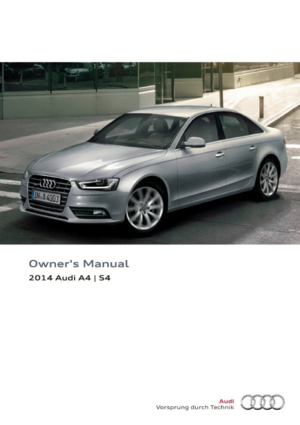 1
1 2
2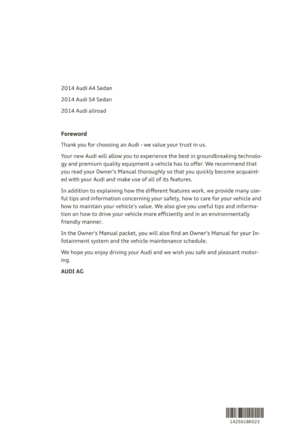 3
3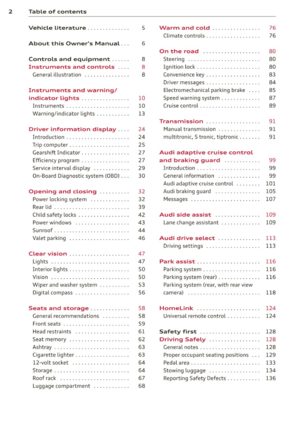 4
4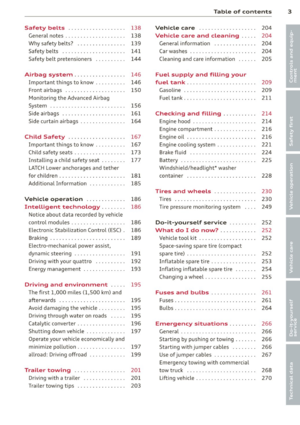 5
5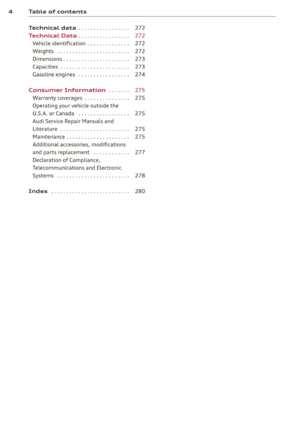 6
6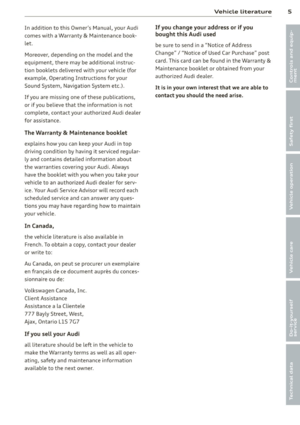 7
7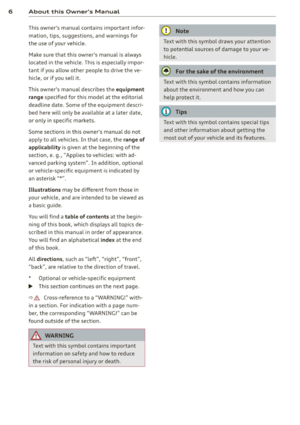 8
8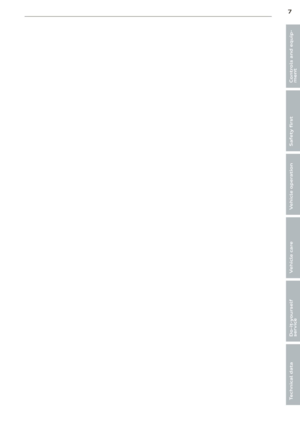 9
9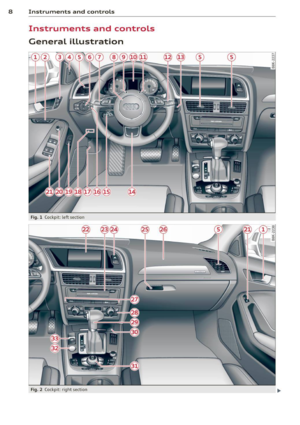 10
10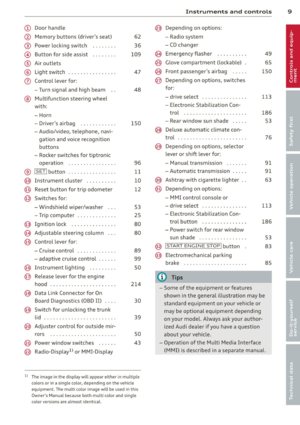 11
11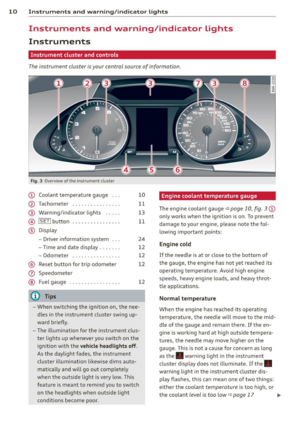 12
12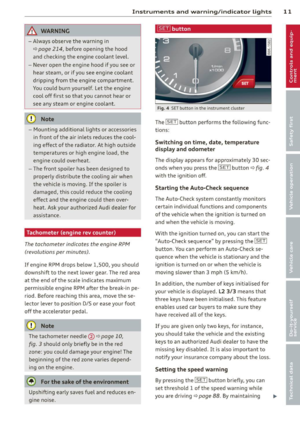 13
13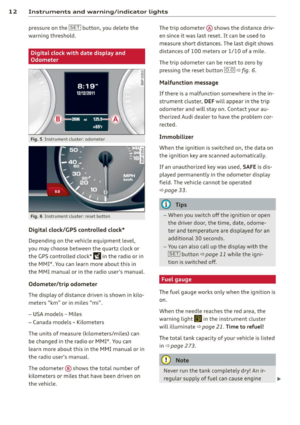 14
14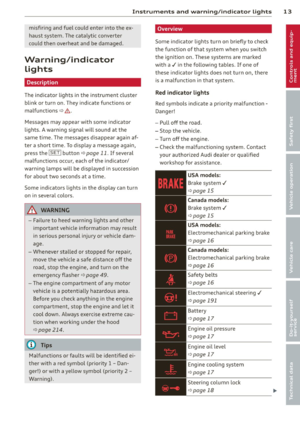 15
15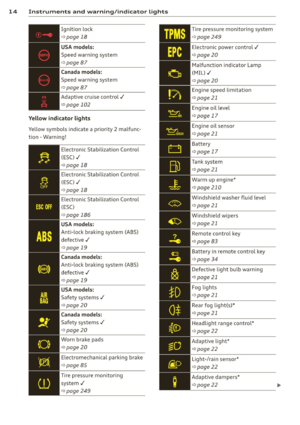 16
16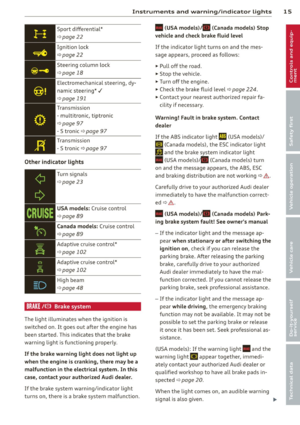 17
17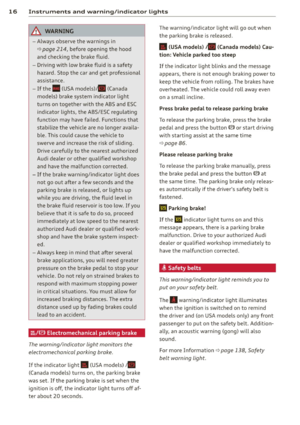 18
18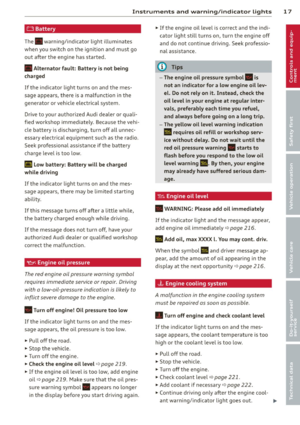 19
19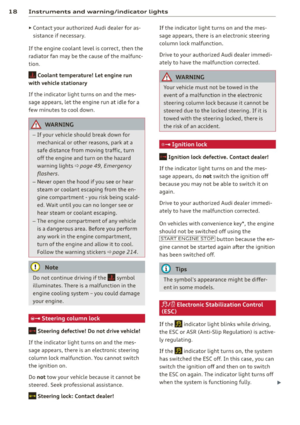 20
20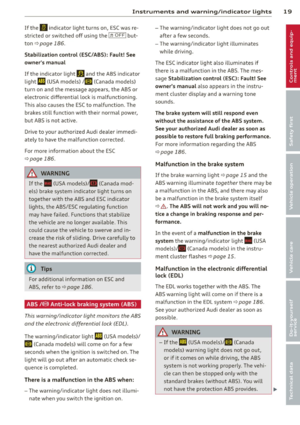 21
21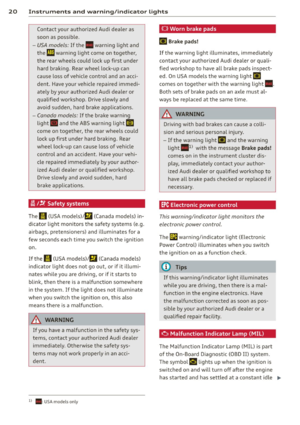 22
22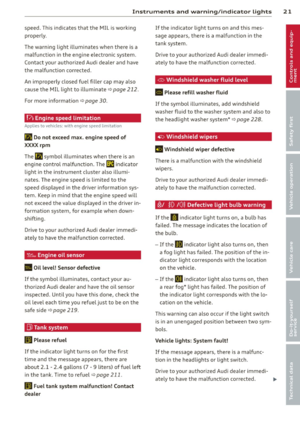 23
23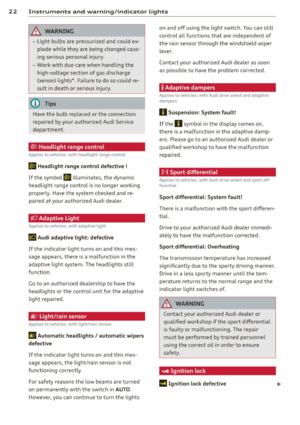 24
24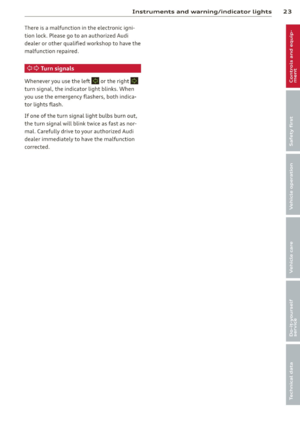 25
25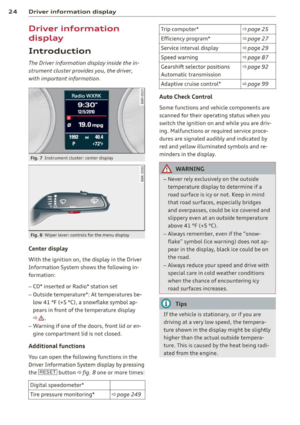 26
26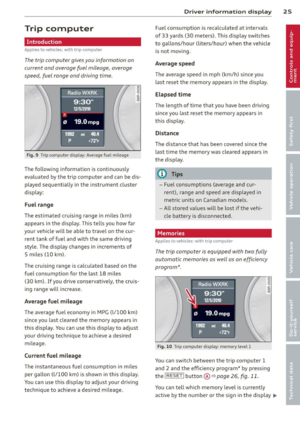 27
27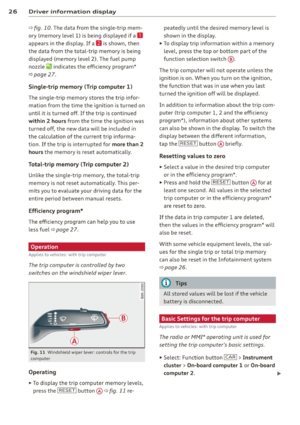 28
28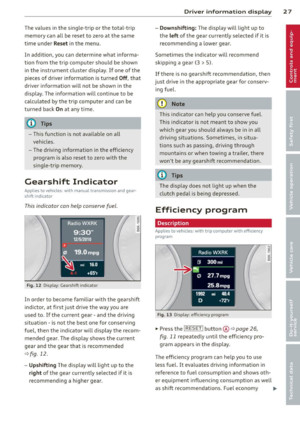 29
29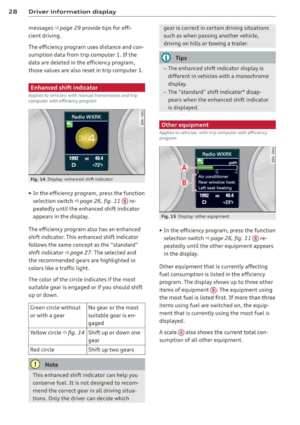 30
30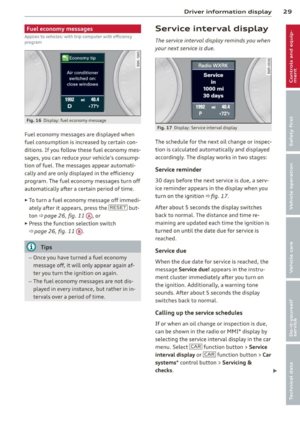 31
31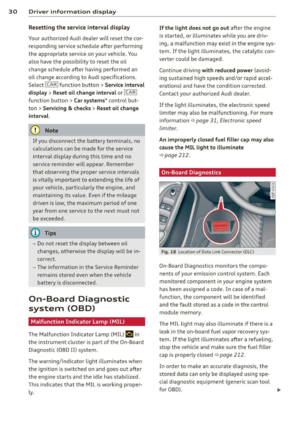 32
32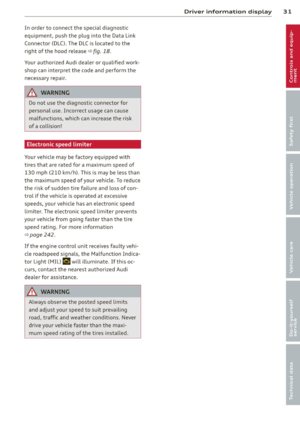 33
33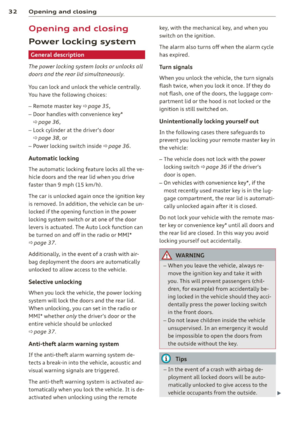 34
34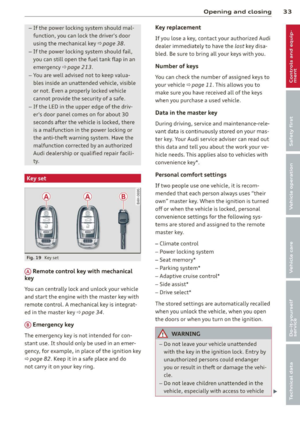 35
35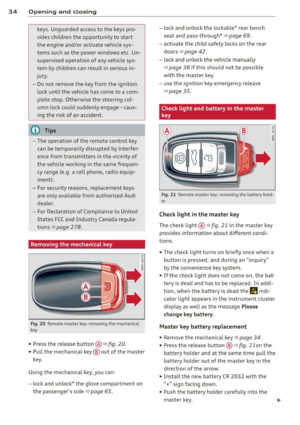 36
36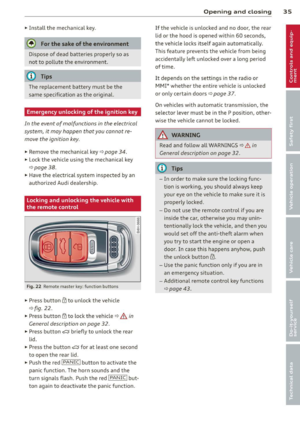 37
37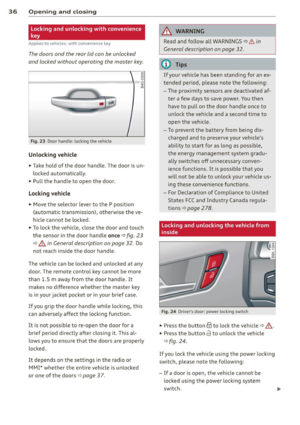 38
38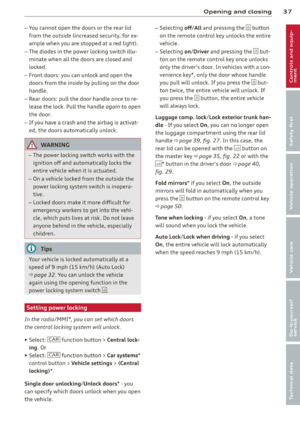 39
39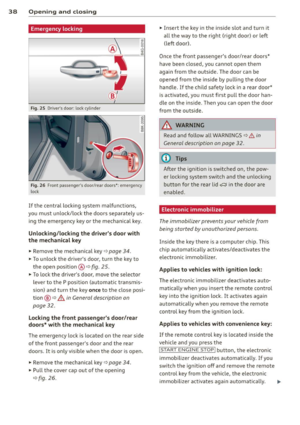 40
40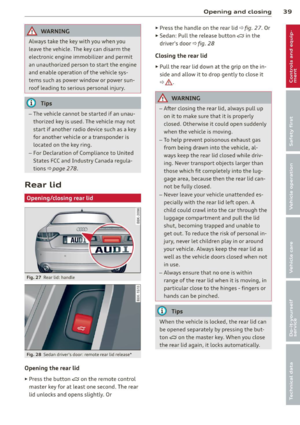 41
41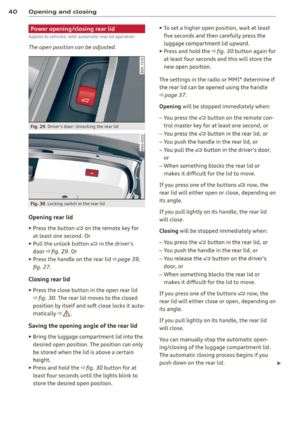 42
42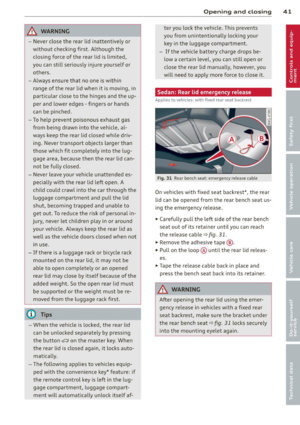 43
43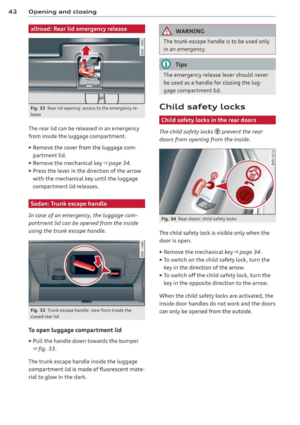 44
44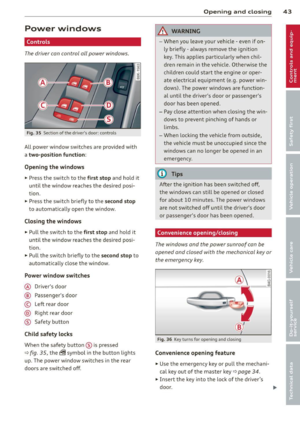 45
45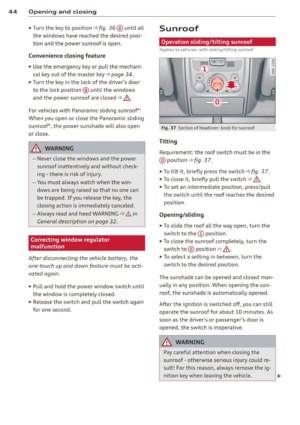 46
46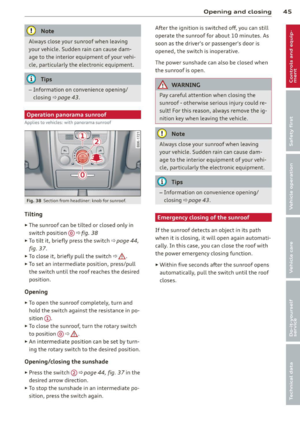 47
47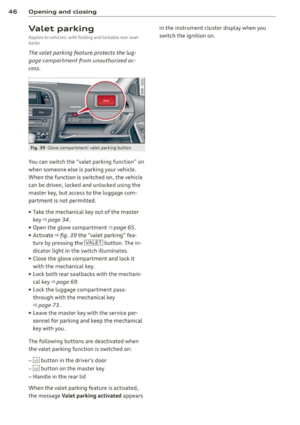 48
48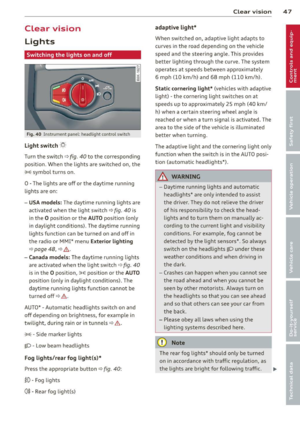 49
49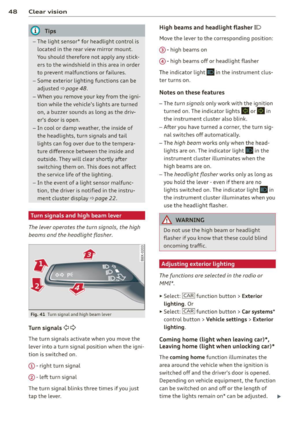 50
50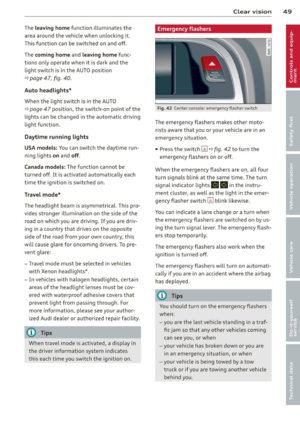 51
51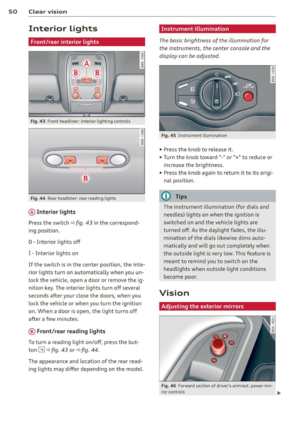 52
52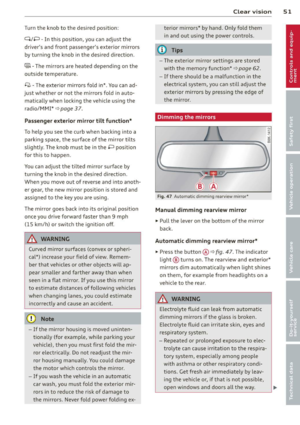 53
53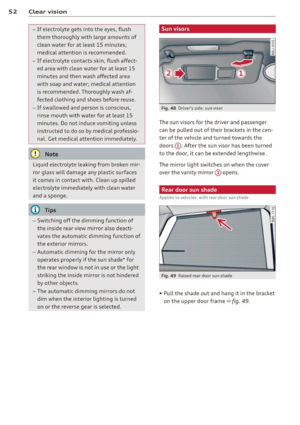 54
54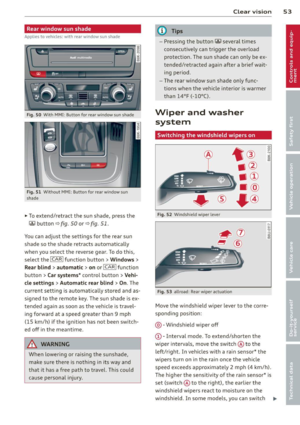 55
55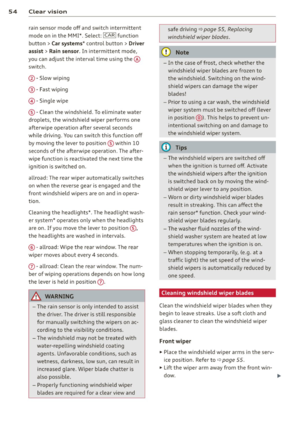 56
56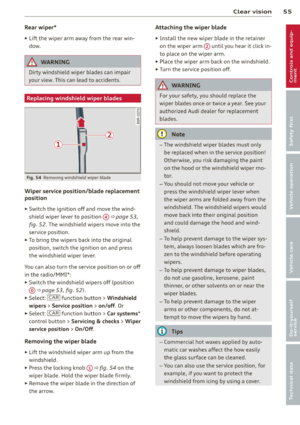 57
57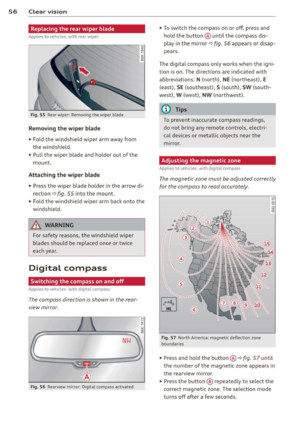 58
58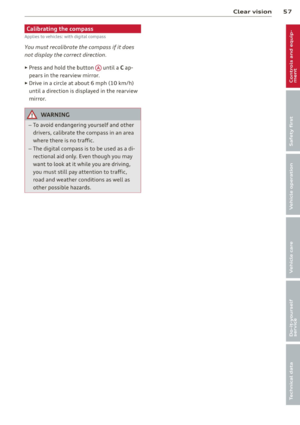 59
59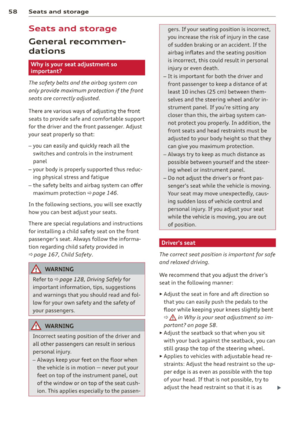 60
60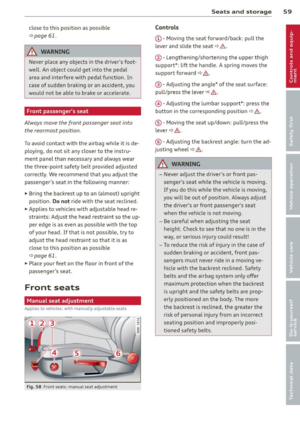 61
61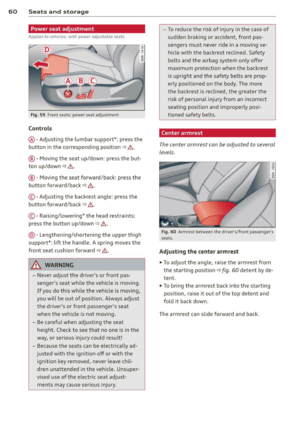 62
62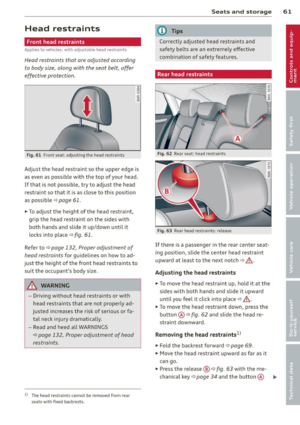 63
63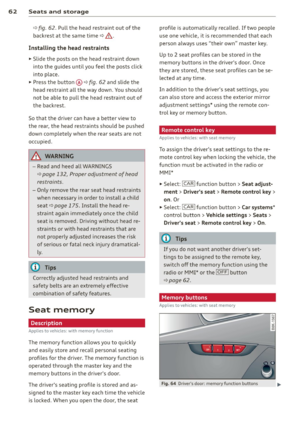 64
64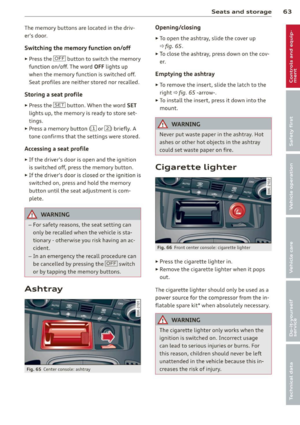 65
65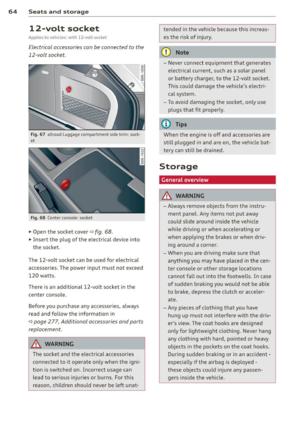 66
66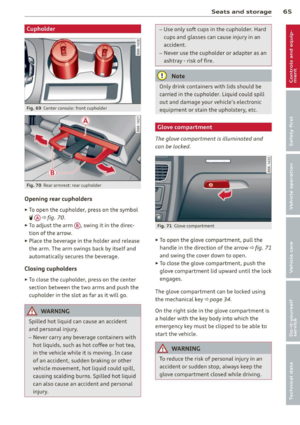 67
67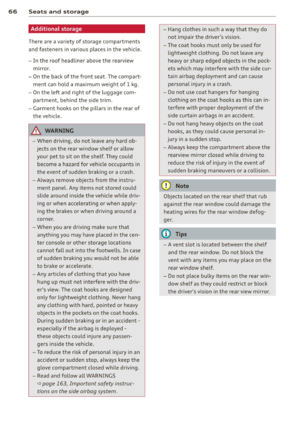 68
68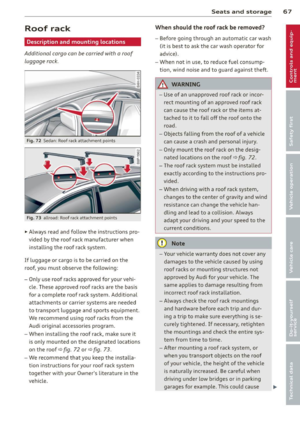 69
69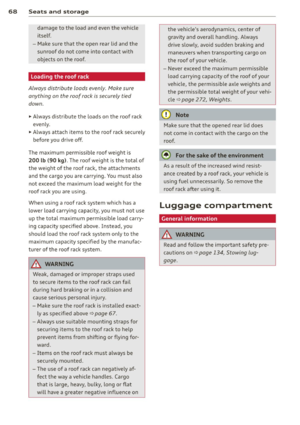 70
70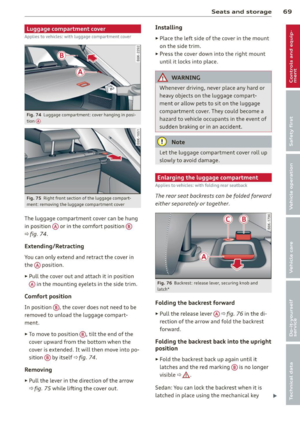 71
71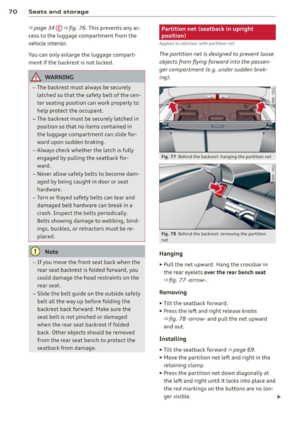 72
72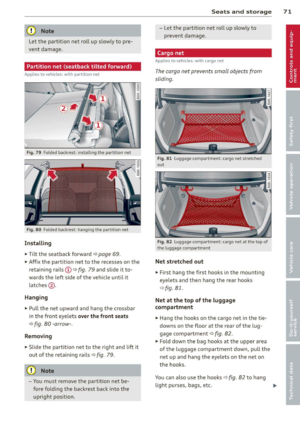 73
73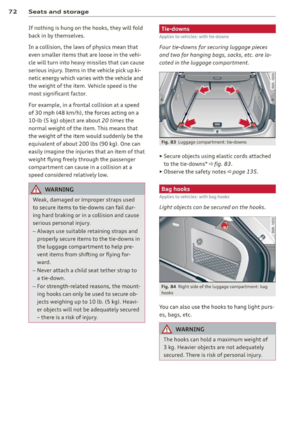 74
74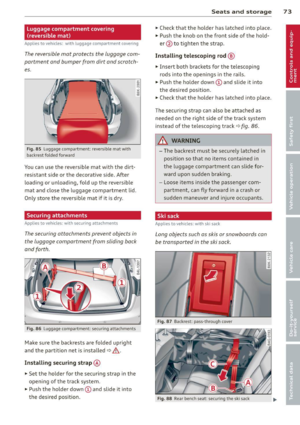 75
75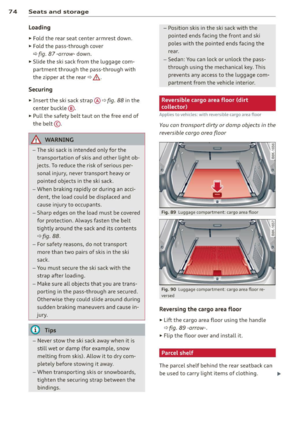 76
76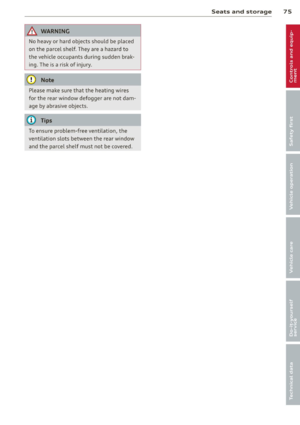 77
77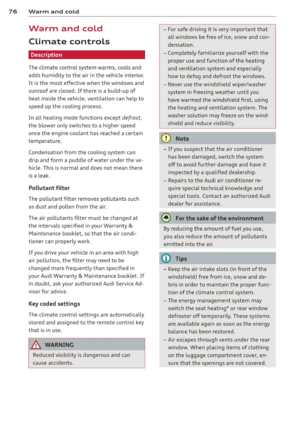 78
78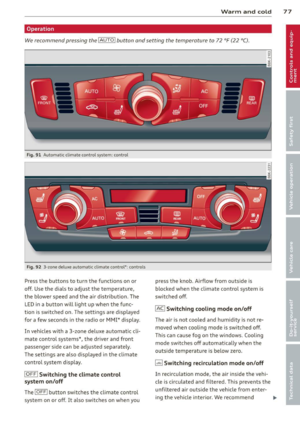 79
79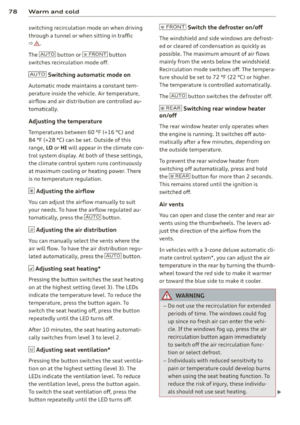 80
80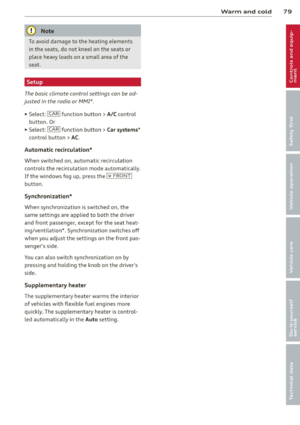 81
81 82
82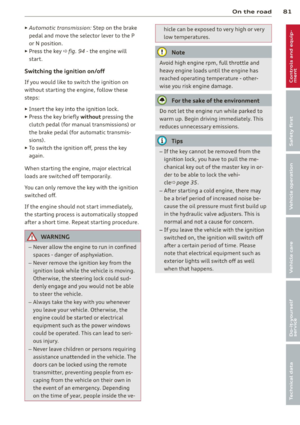 83
83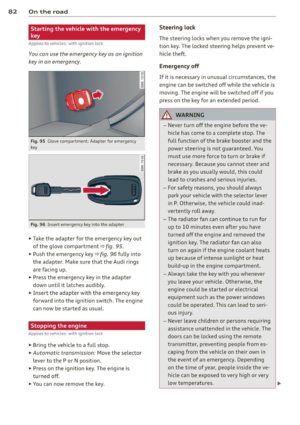 84
84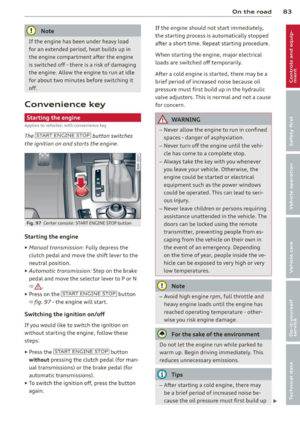 85
85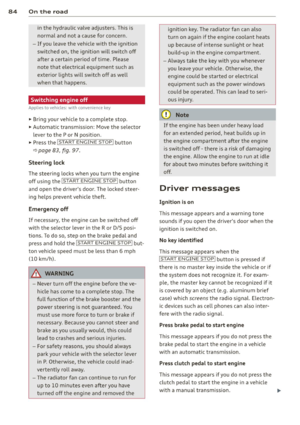 86
86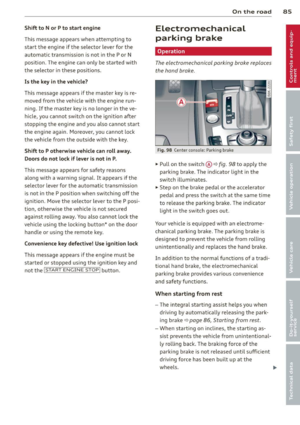 87
87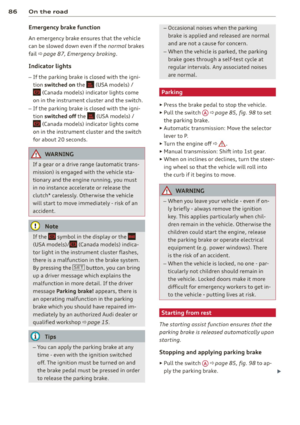 88
88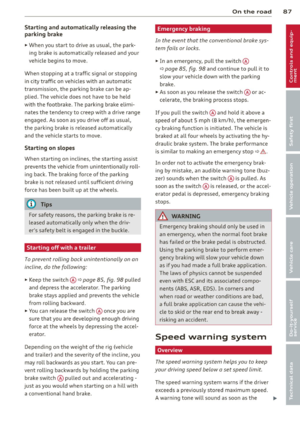 89
89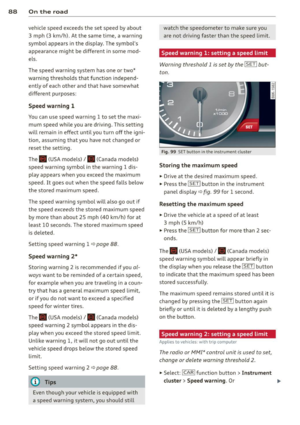 90
90 91
91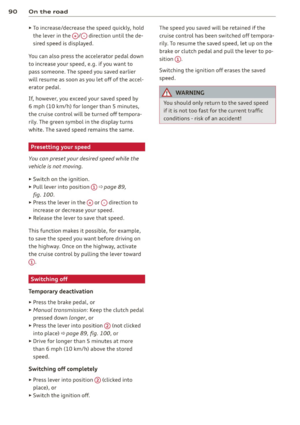 92
92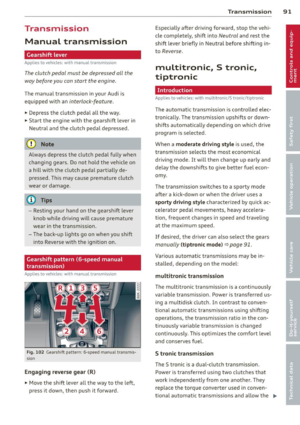 93
93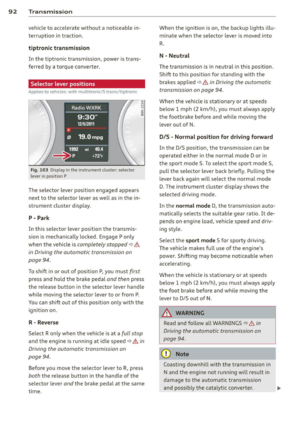 94
94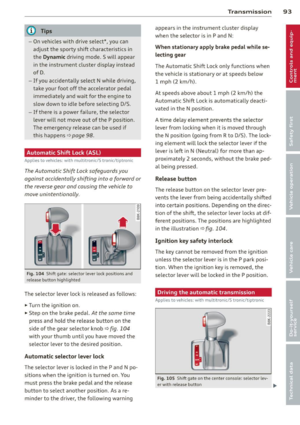 95
95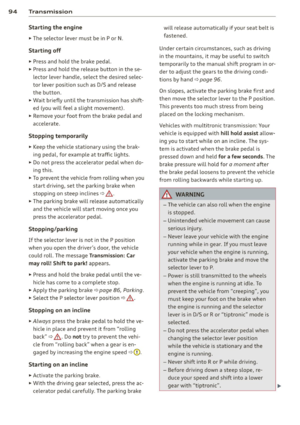 96
96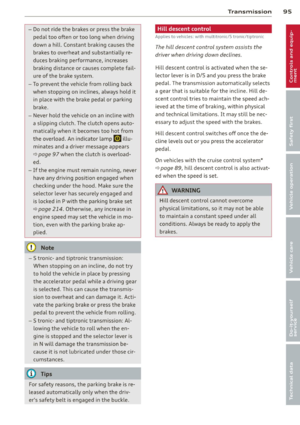 97
97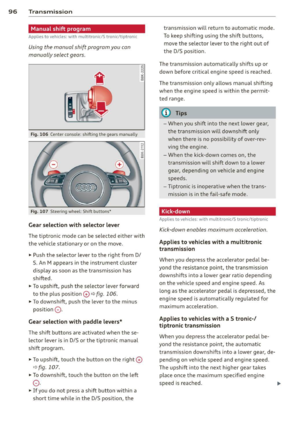 98
98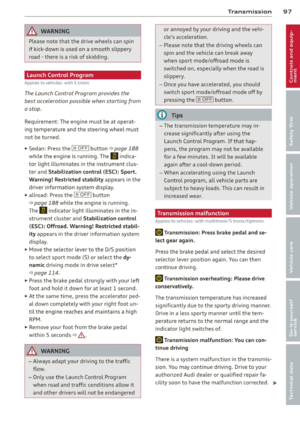 99
99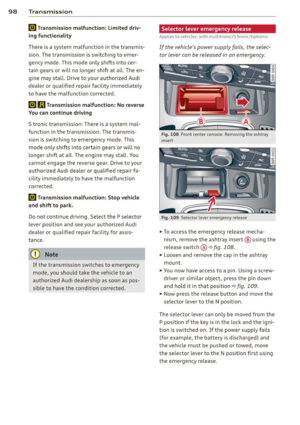 100
100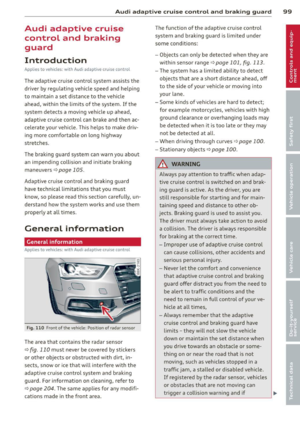 101
101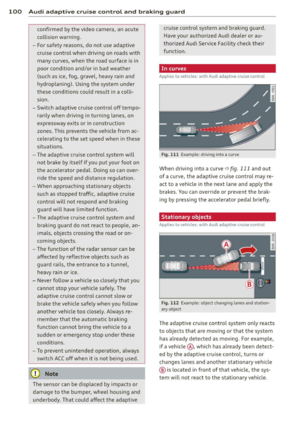 102
102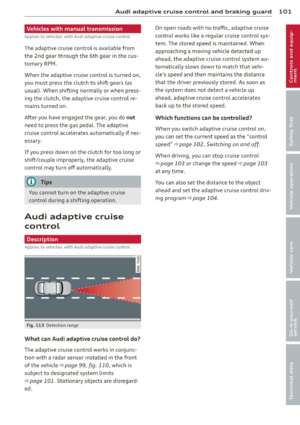 103
103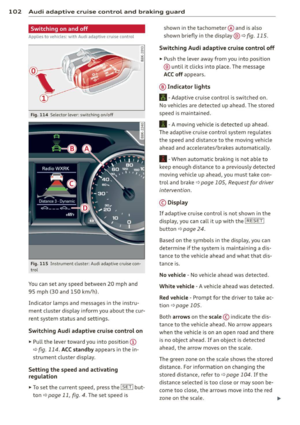 104
104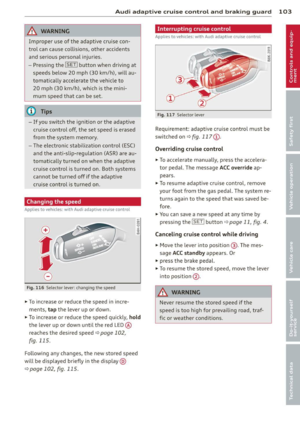 105
105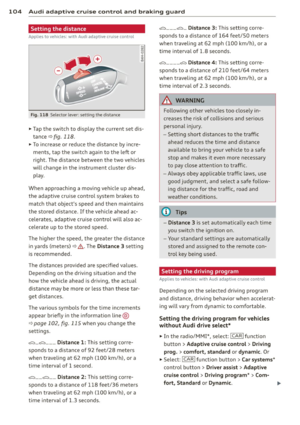 106
106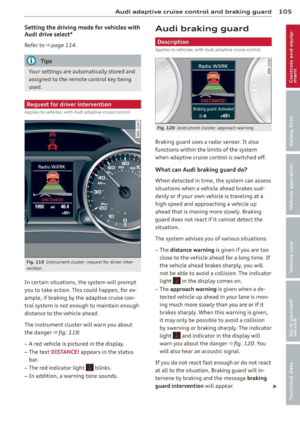 107
107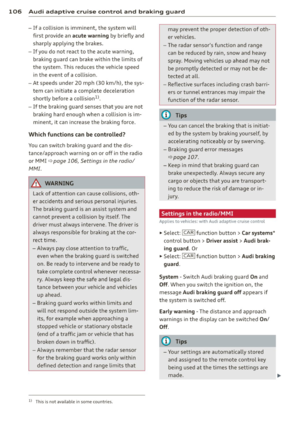 108
108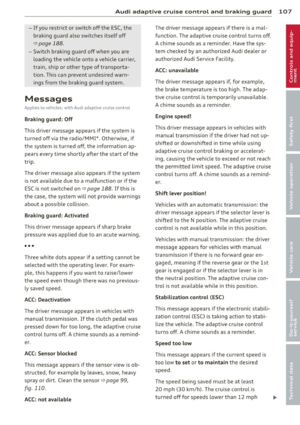 109
109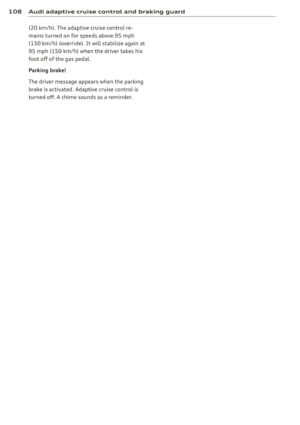 110
110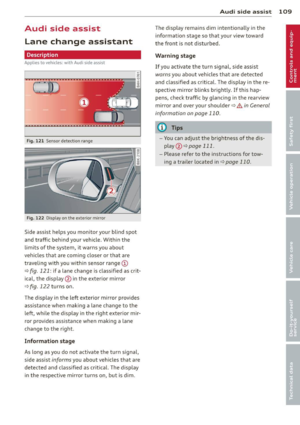 111
111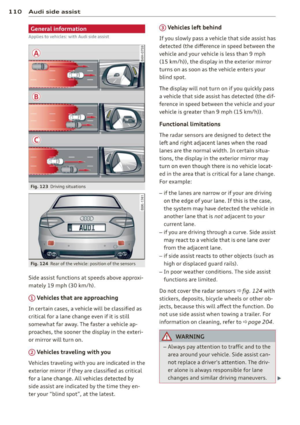 112
112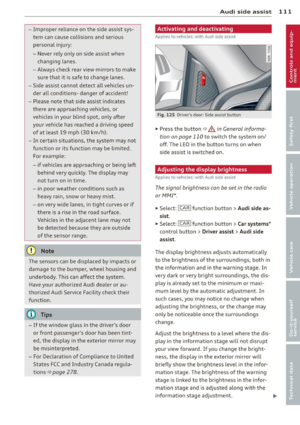 113
113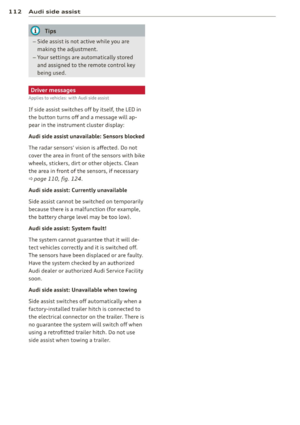 114
114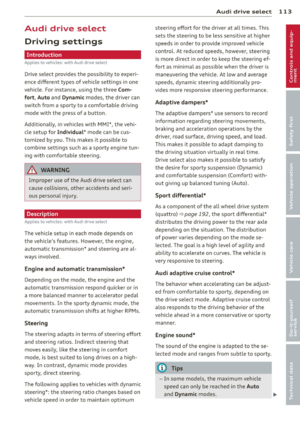 115
115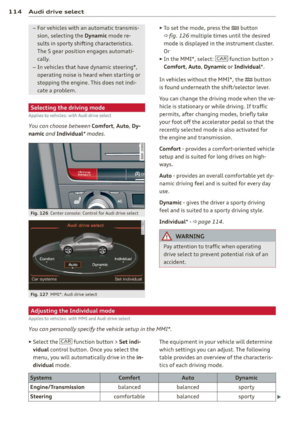 116
116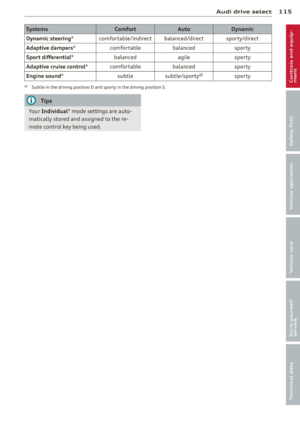 117
117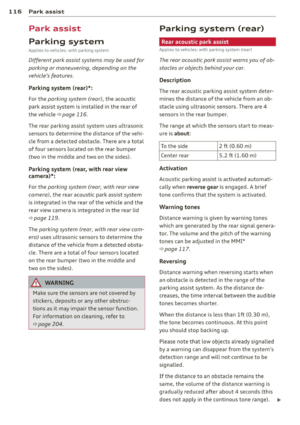 118
118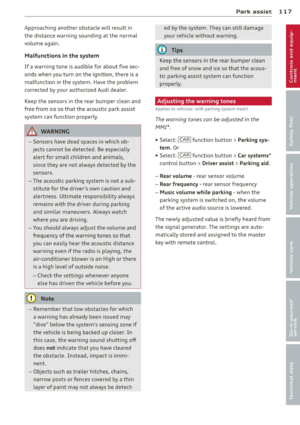 119
119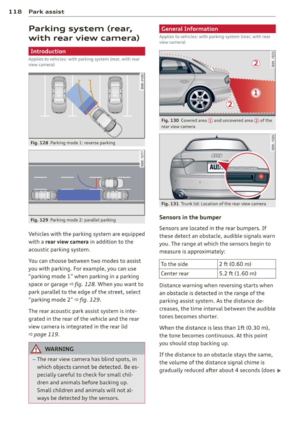 120
120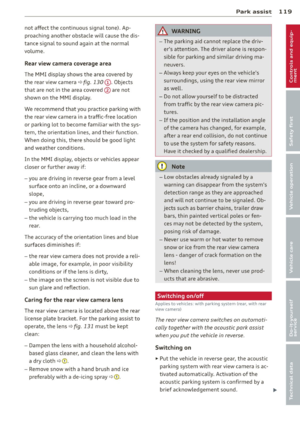 121
121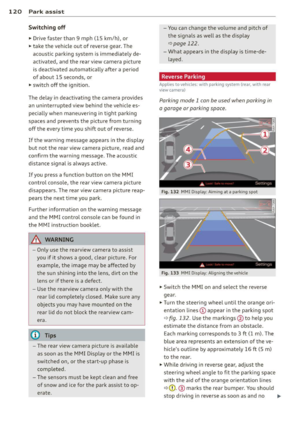 122
122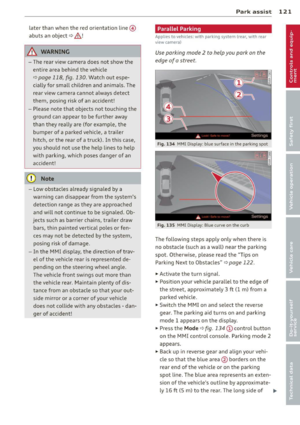 123
123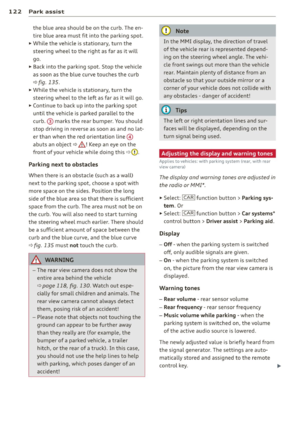 124
124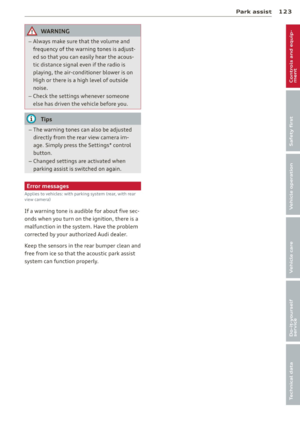 125
125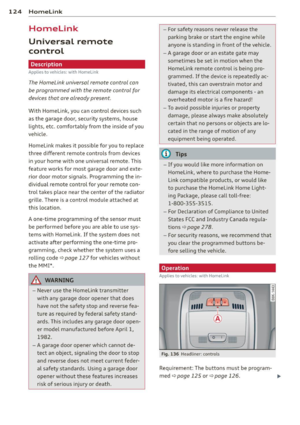 126
126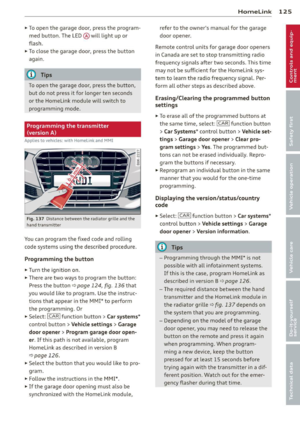 127
127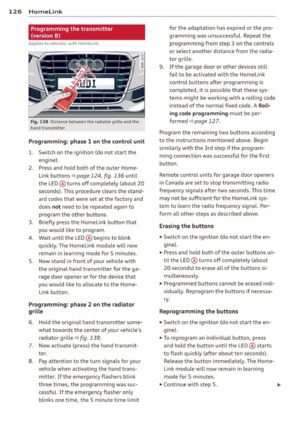 128
128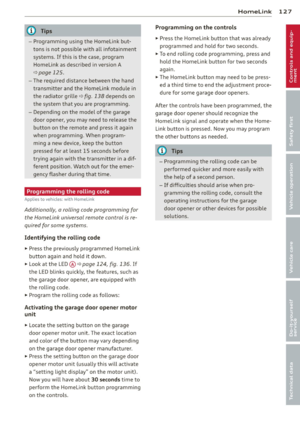 129
129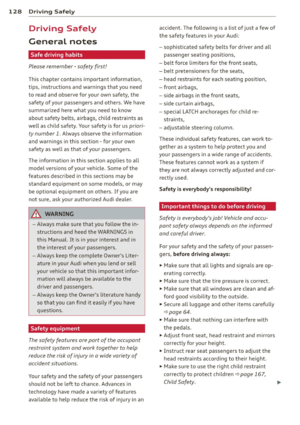 130
130 131
131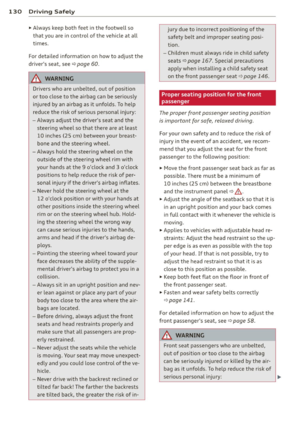 132
132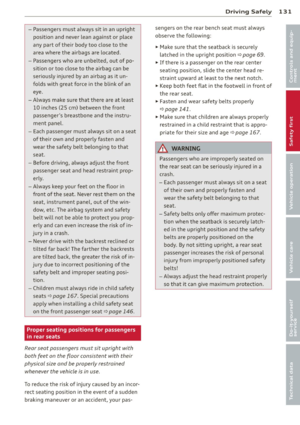 133
133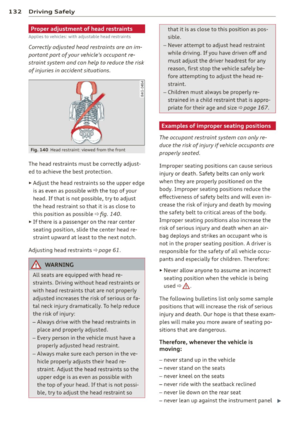 134
134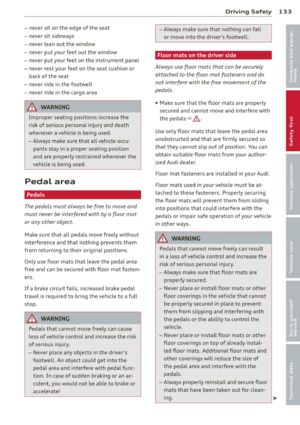 135
135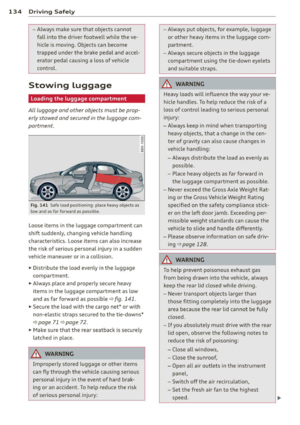 136
136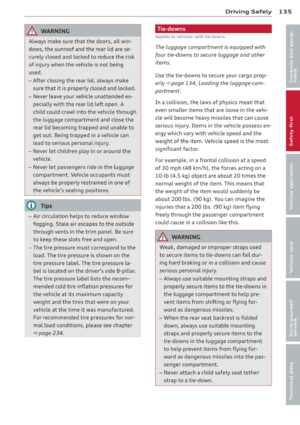 137
137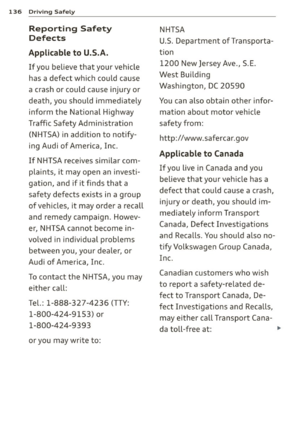 138
138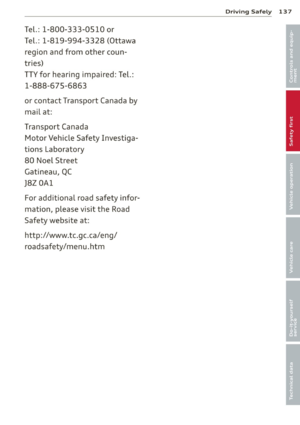 139
139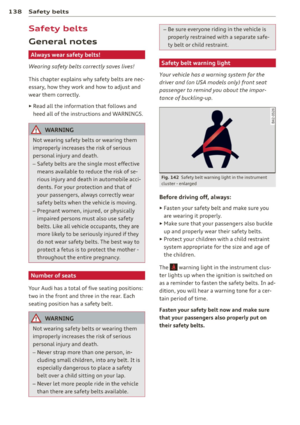 140
140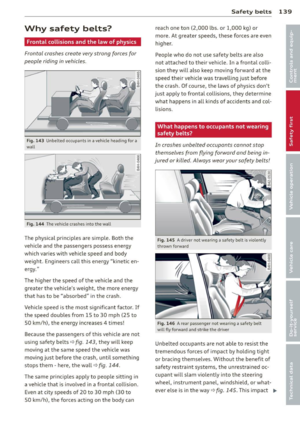 141
141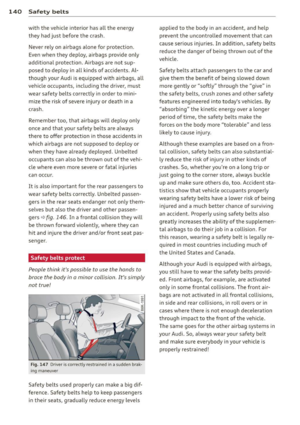 142
142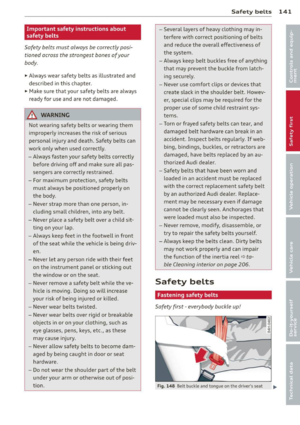 143
143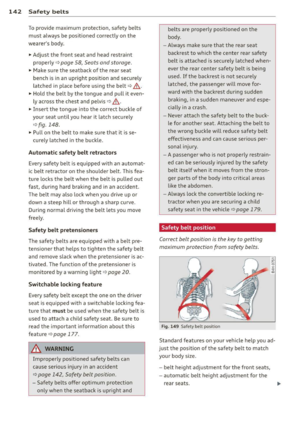 144
144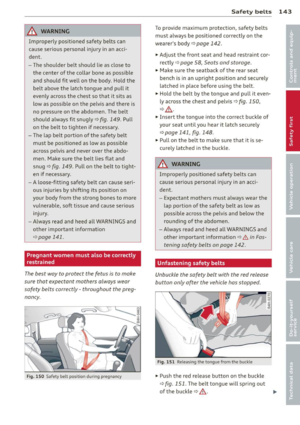 145
145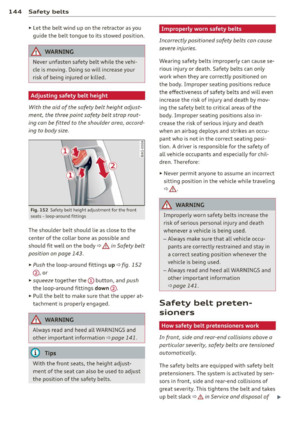 146
146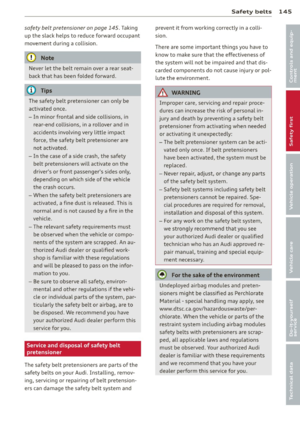 147
147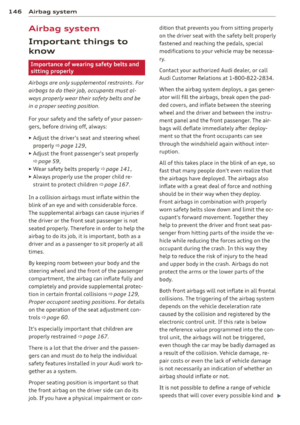 148
148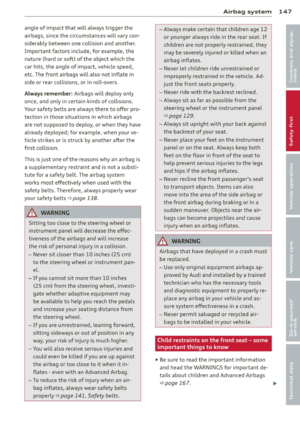 149
149 150
150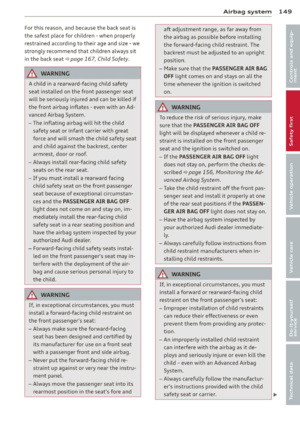 151
151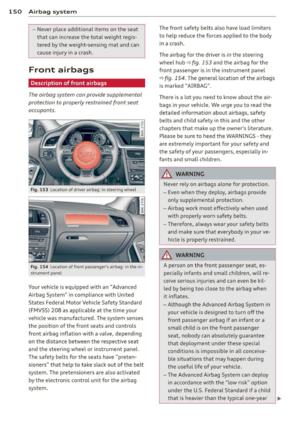 152
152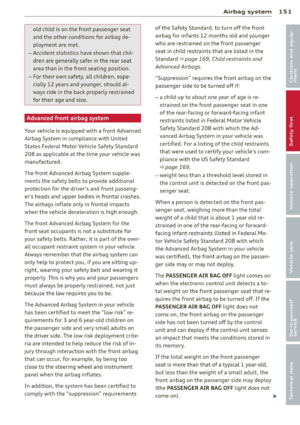 153
153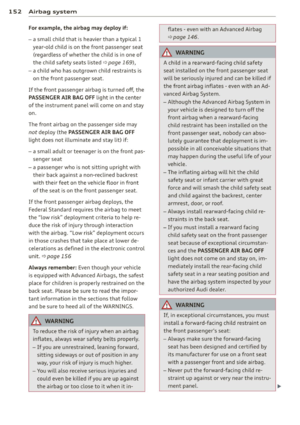 154
154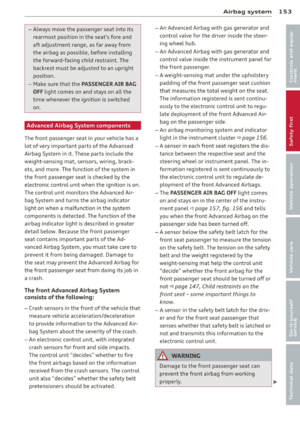 155
155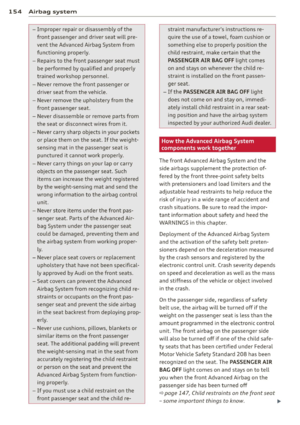 156
156 157
157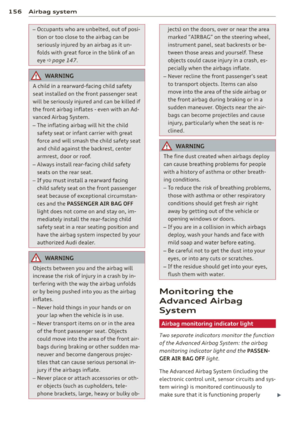 158
158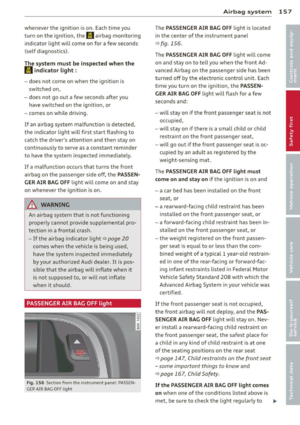 159
159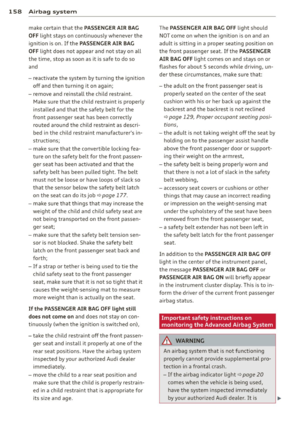 160
160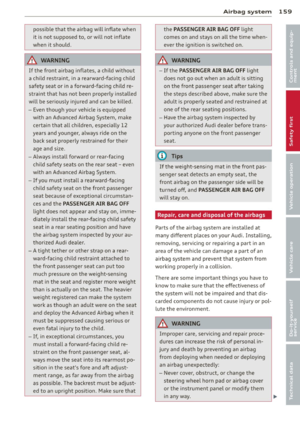 161
161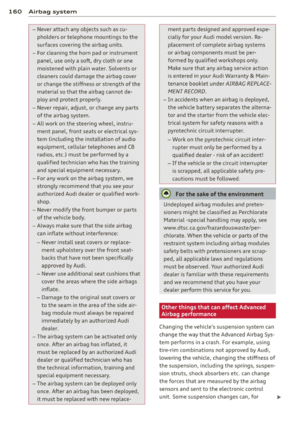 162
162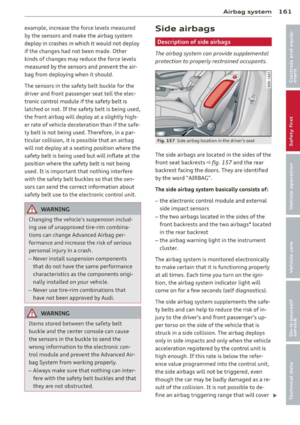 163
163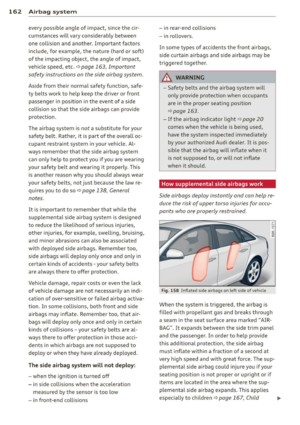 164
164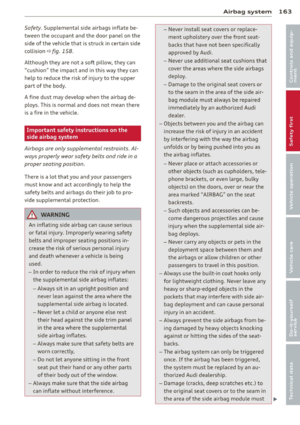 165
165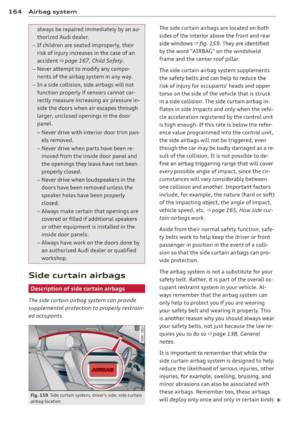 166
166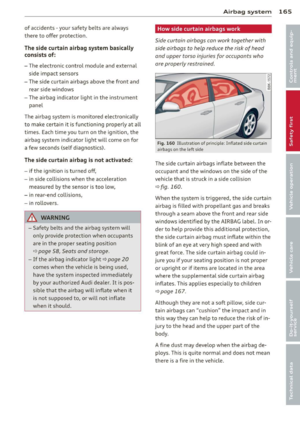 167
167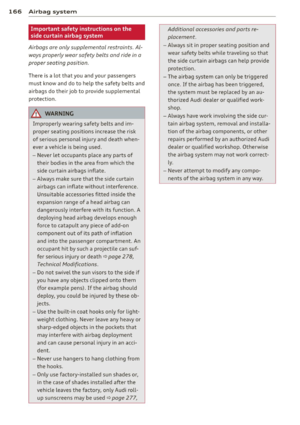 168
168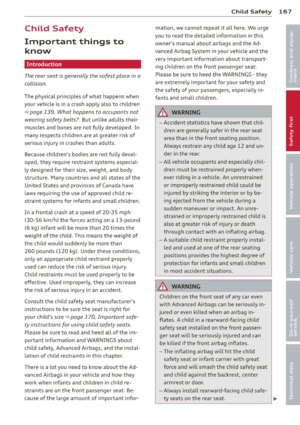 169
169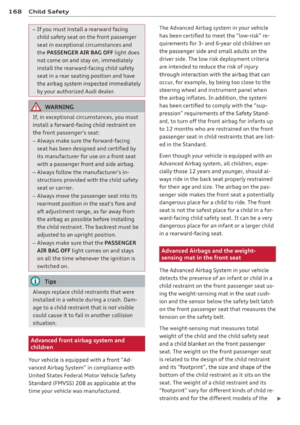 170
170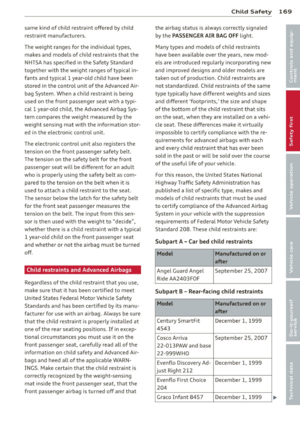 171
171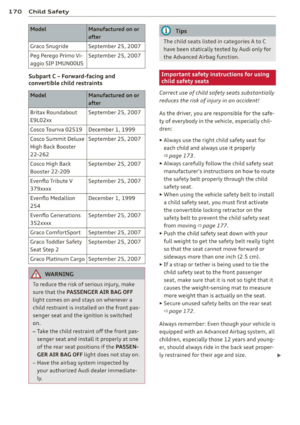 172
172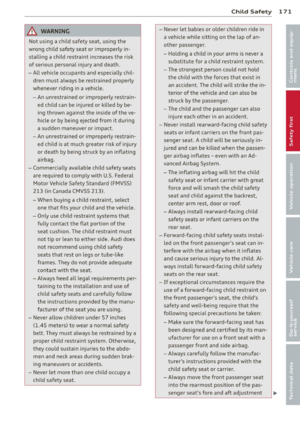 173
173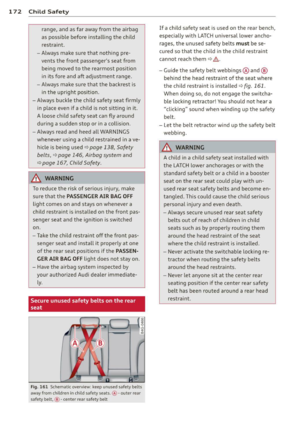 174
174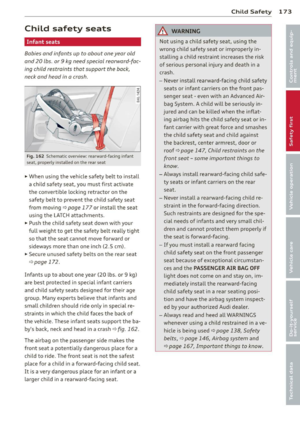 175
175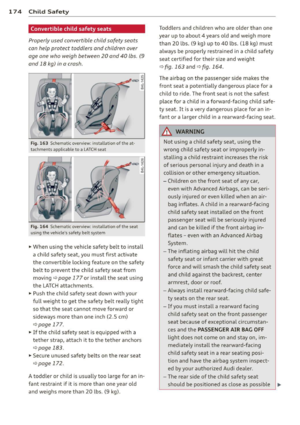 176
176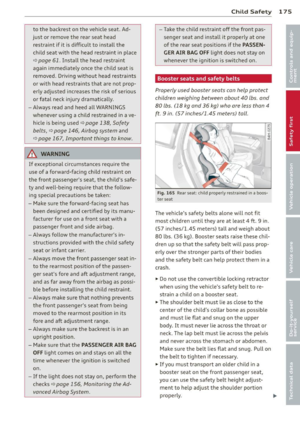 177
177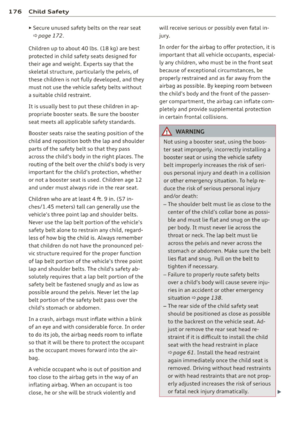 178
178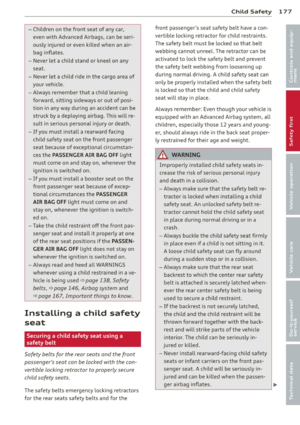 179
179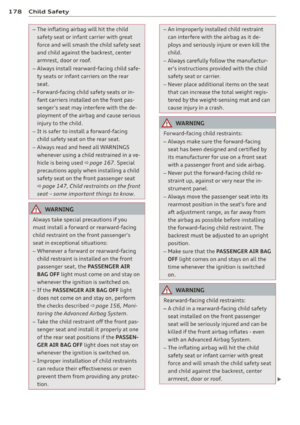 180
180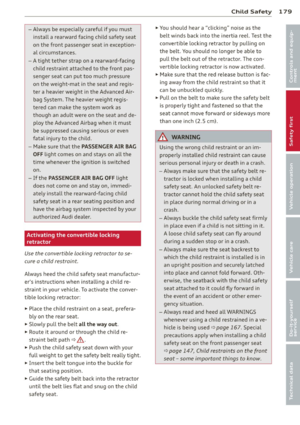 181
181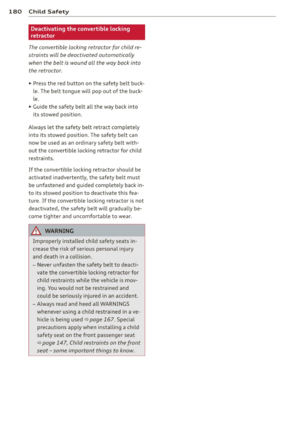 182
182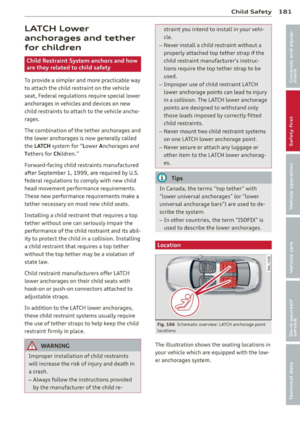 183
183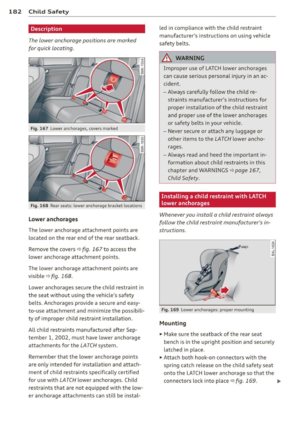 184
184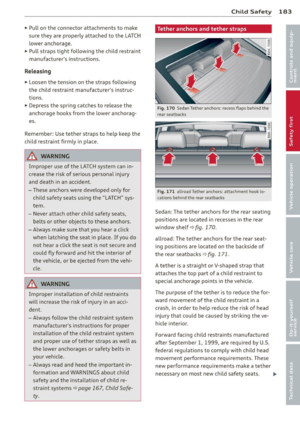 185
185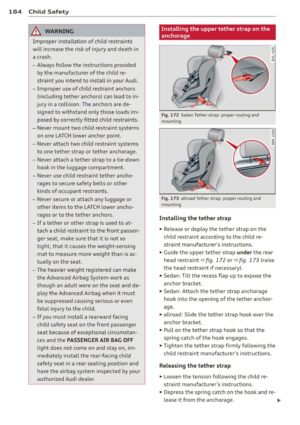 186
186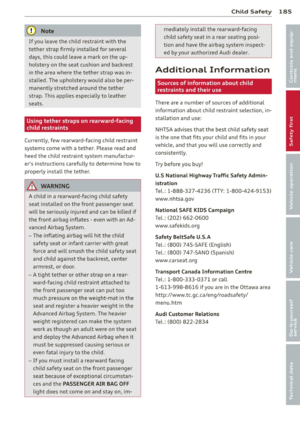 187
187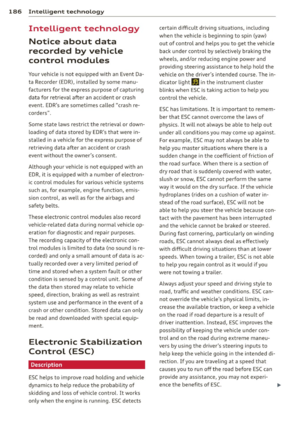 188
188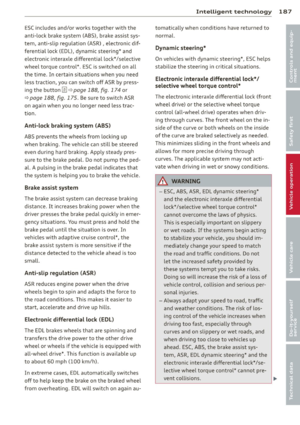 189
189 190
190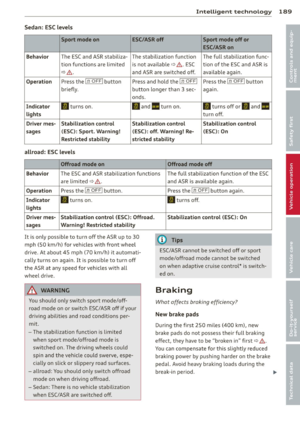 191
191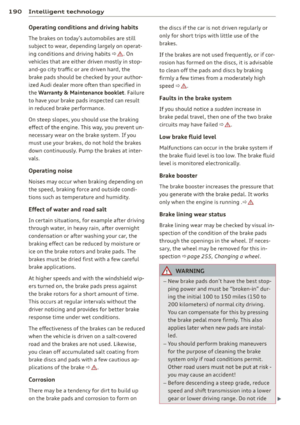 192
192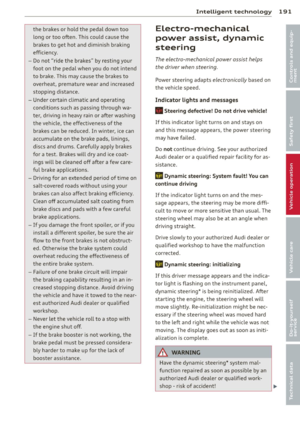 193
193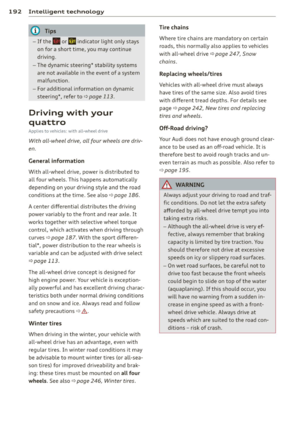 194
194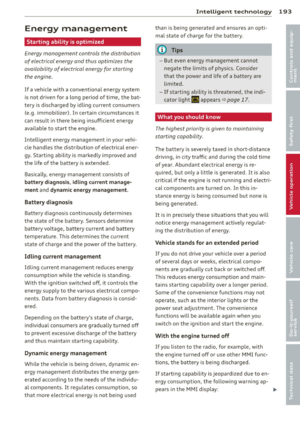 195
195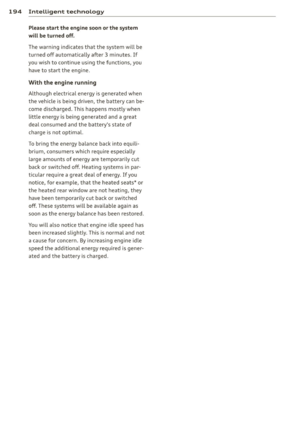 196
196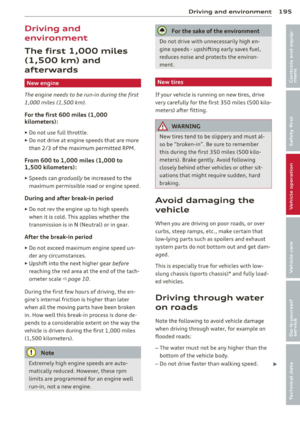 197
197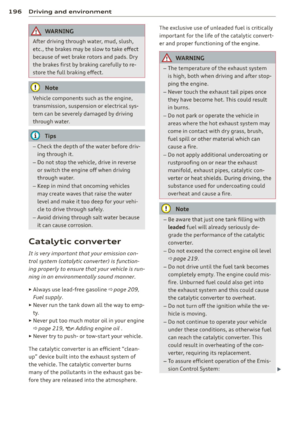 198
198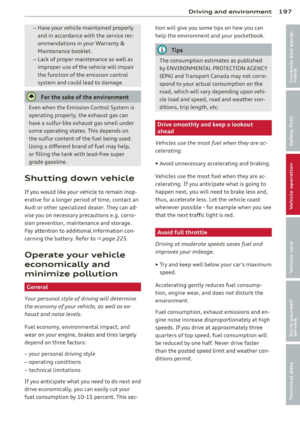 199
199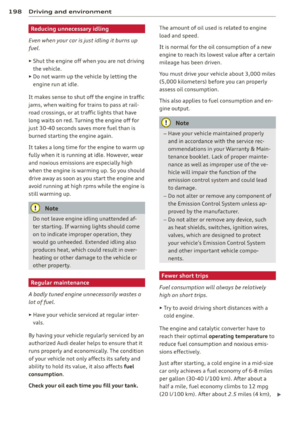 200
200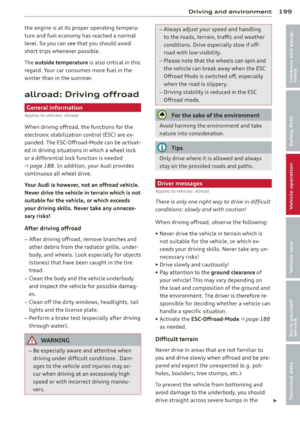 201
201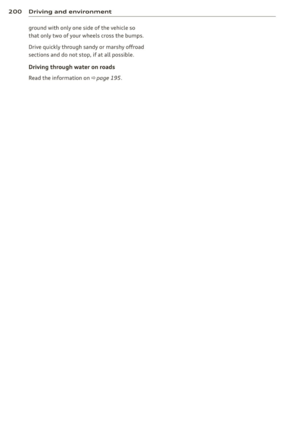 202
202 203
203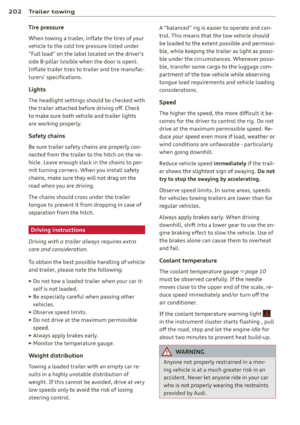 204
204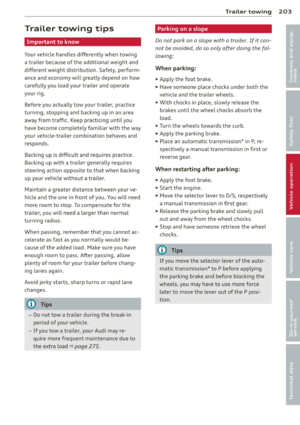 205
205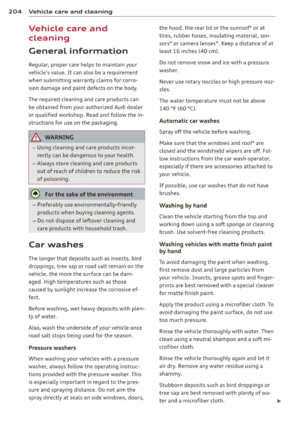 206
206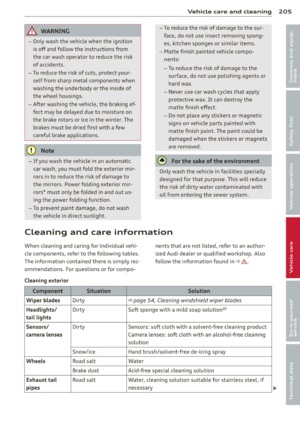 207
207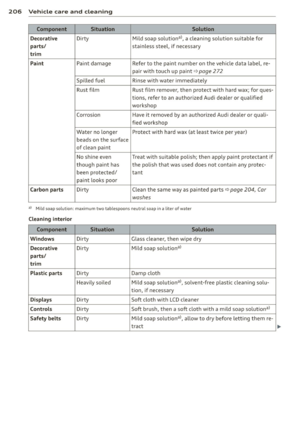 208
208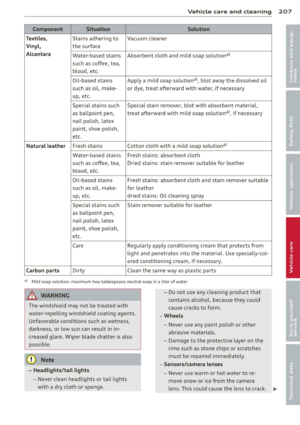 209
209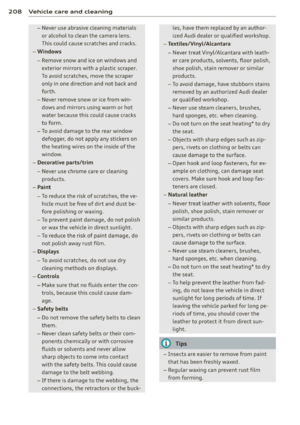 210
210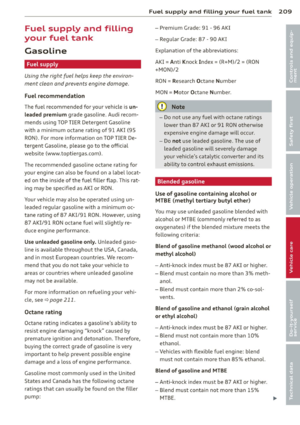 211
211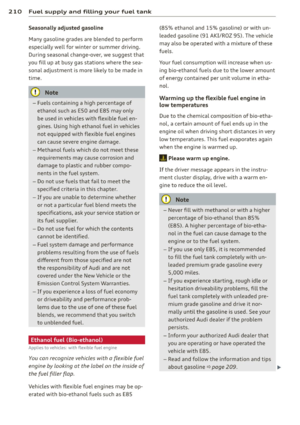 212
212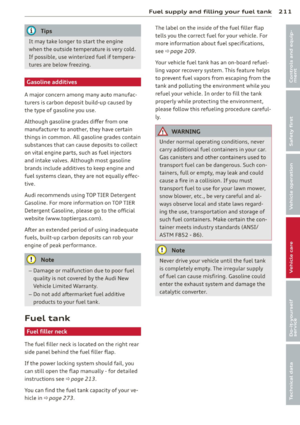 213
213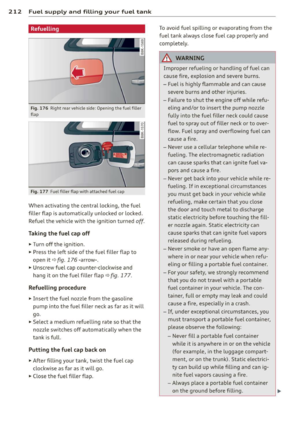 214
214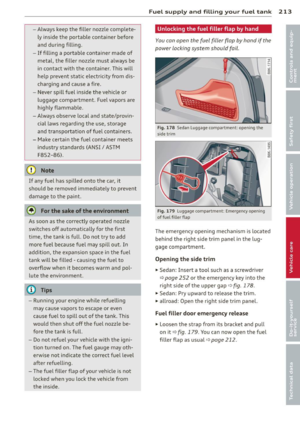 215
215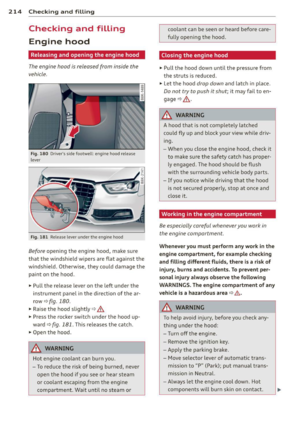 216
216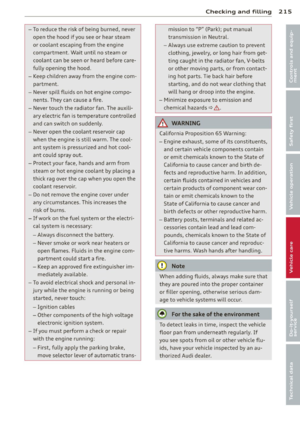 217
217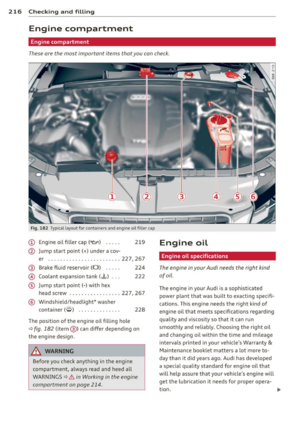 218
218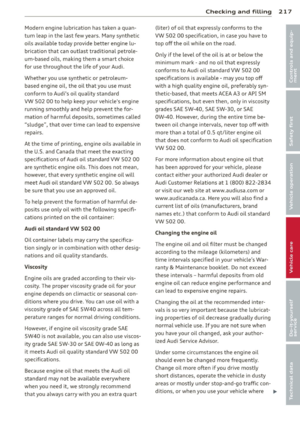 219
219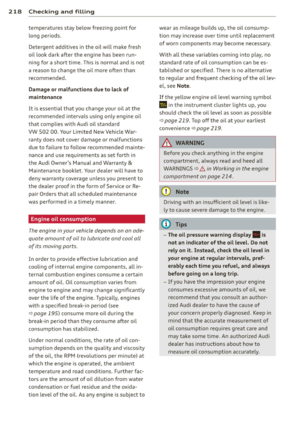 220
220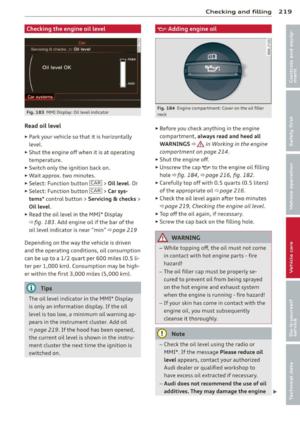 221
221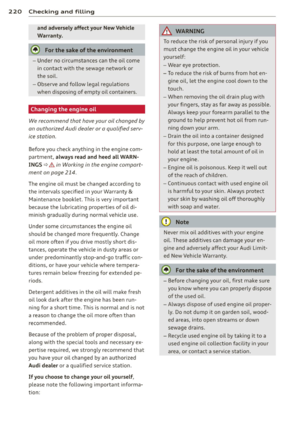 222
222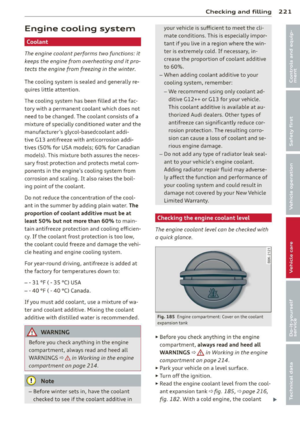 223
223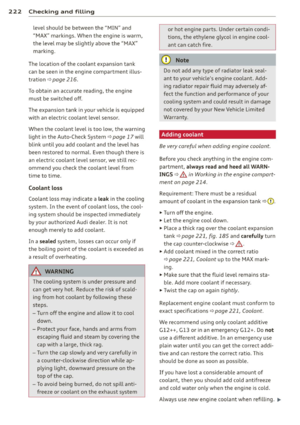 224
224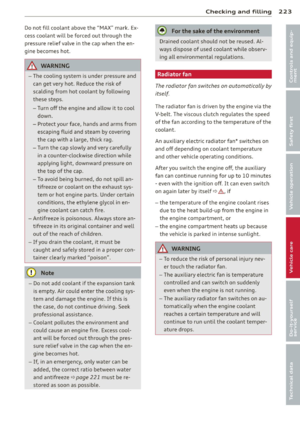 225
225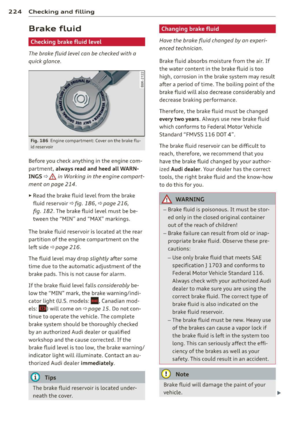 226
226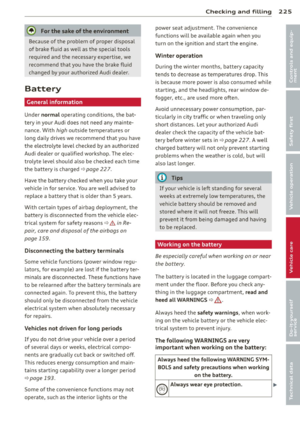 227
227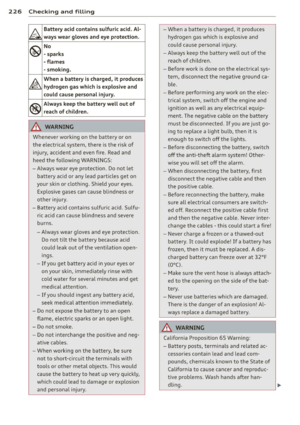 228
228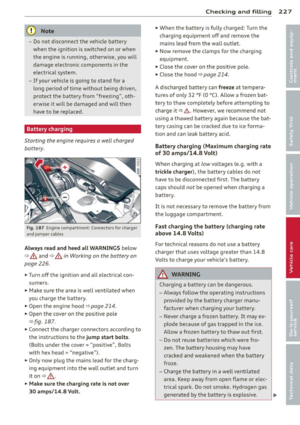 229
229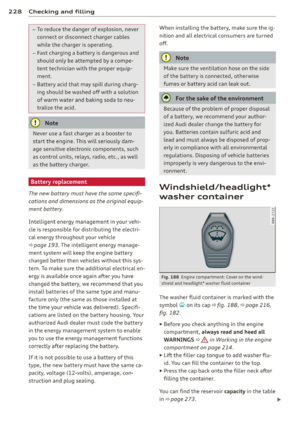 230
230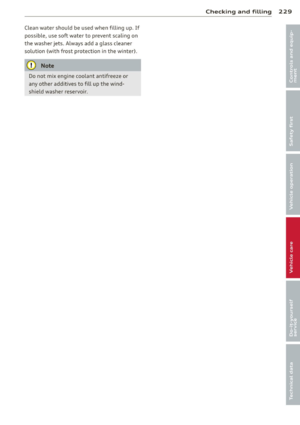 231
231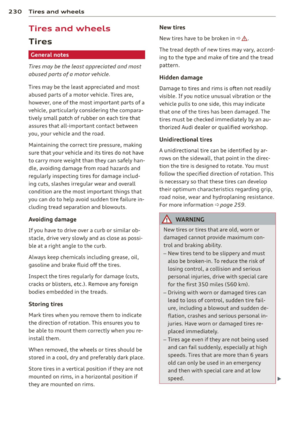 232
232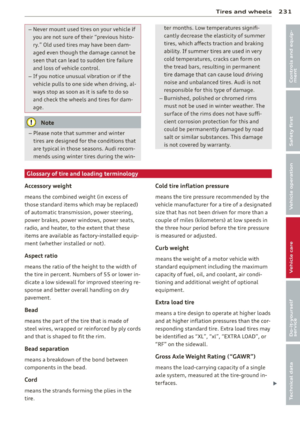 233
233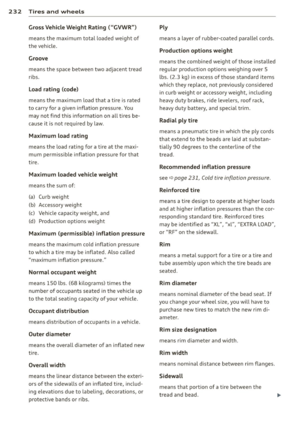 234
234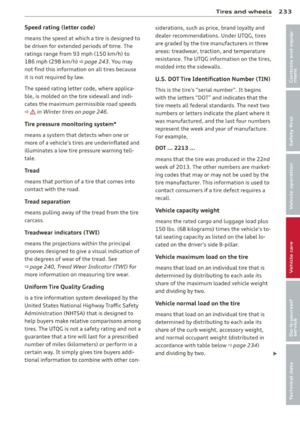 235
235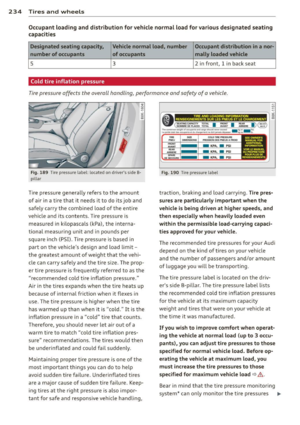 236
236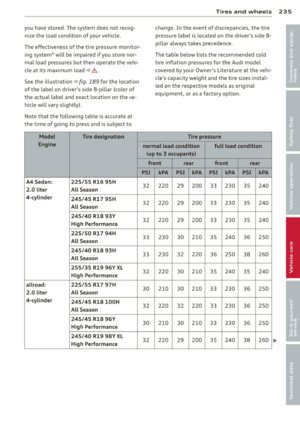 237
237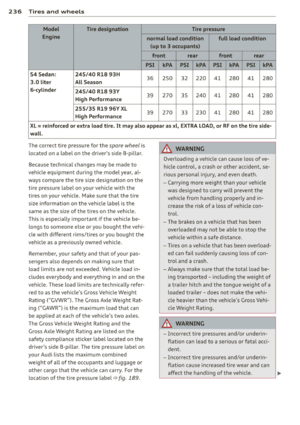 238
238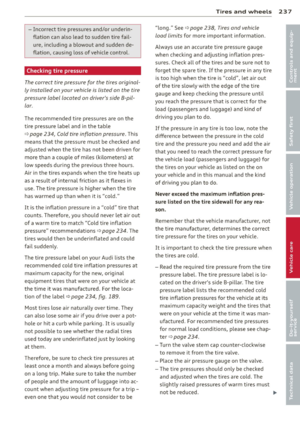 239
239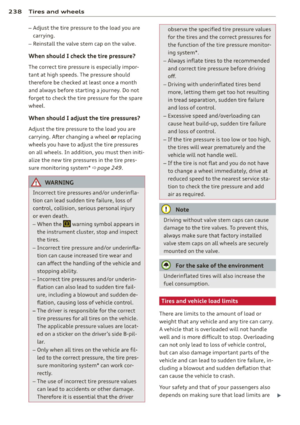 240
240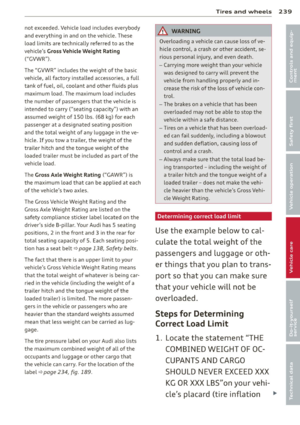 241
241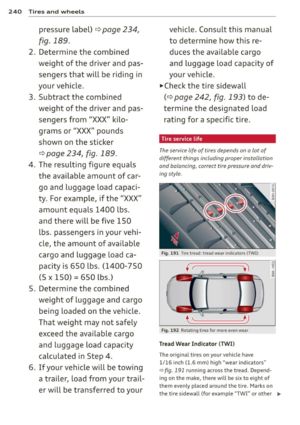 242
242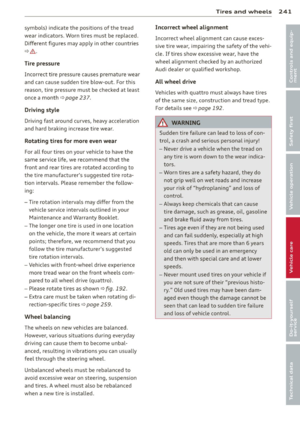 243
243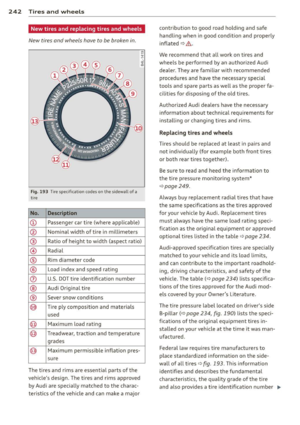 244
244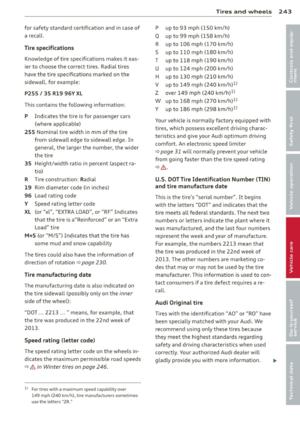 245
245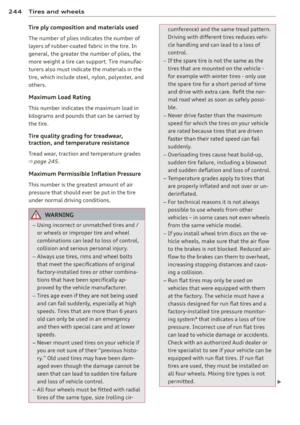 246
246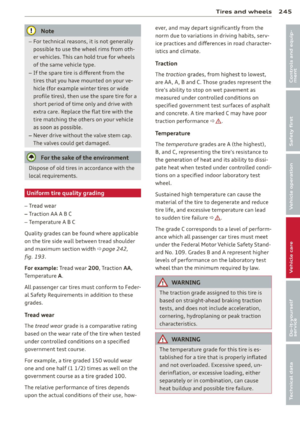 247
247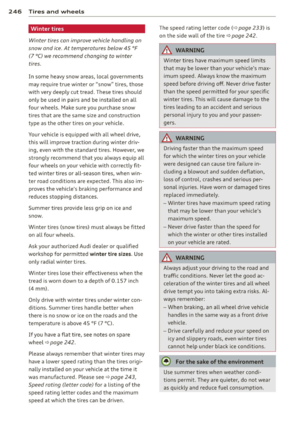 248
248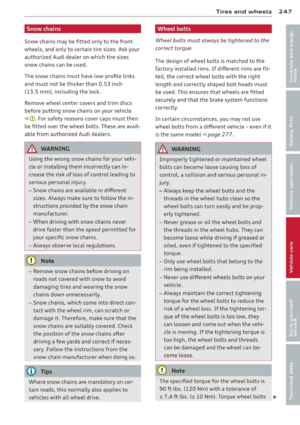 249
249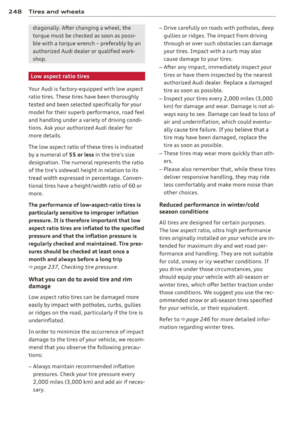 250
250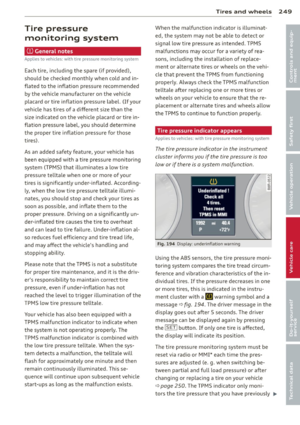 251
251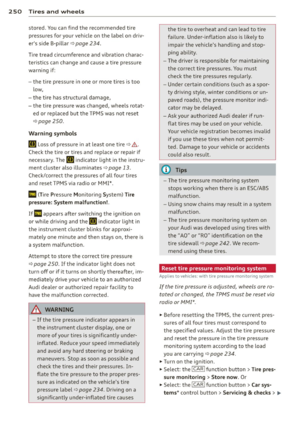 252
252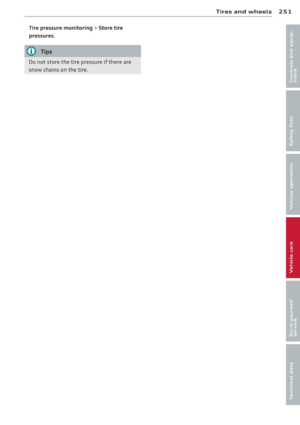 253
253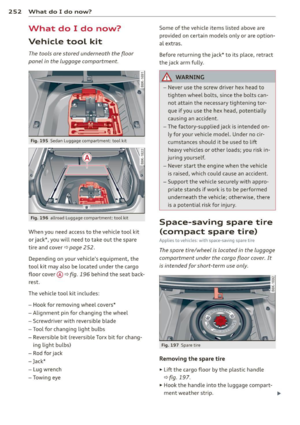 254
254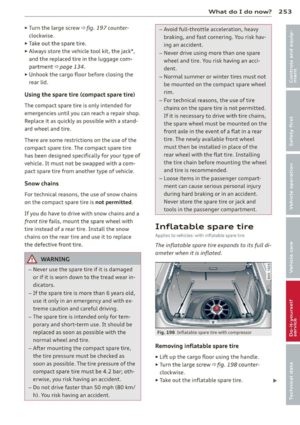 255
255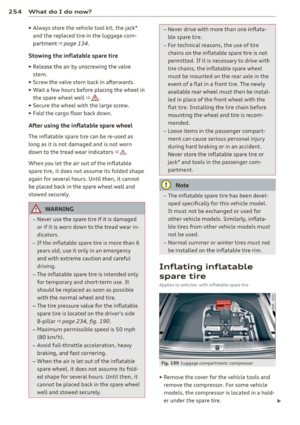 256
256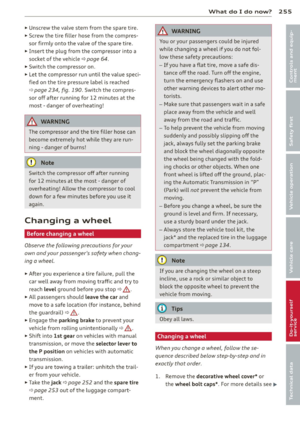 257
257 258
258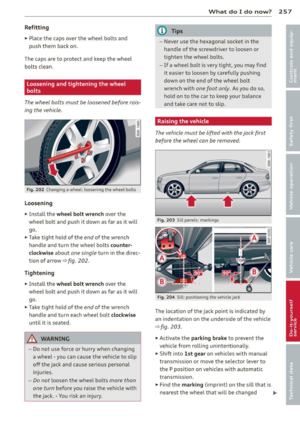 259
259 260
260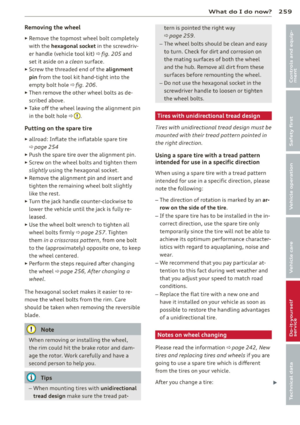 261
261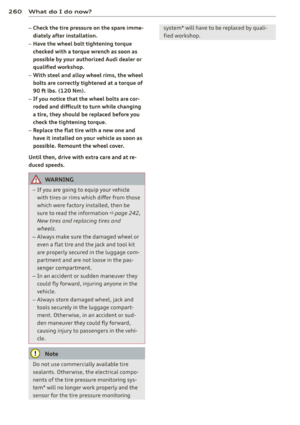 262
262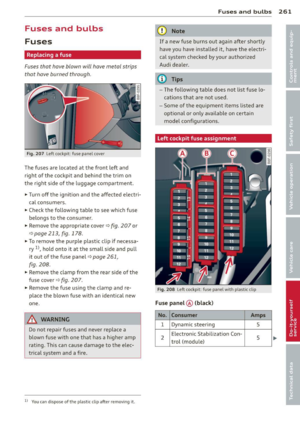 263
263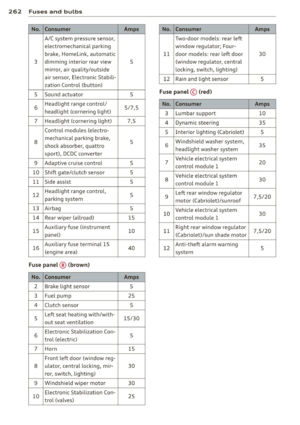 264
264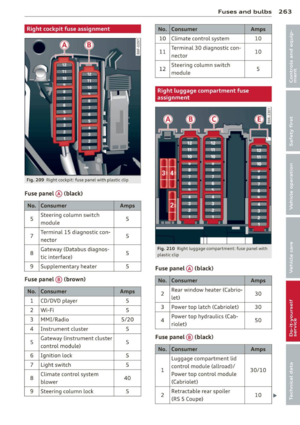 265
265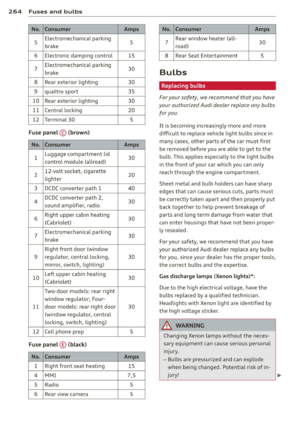 266
266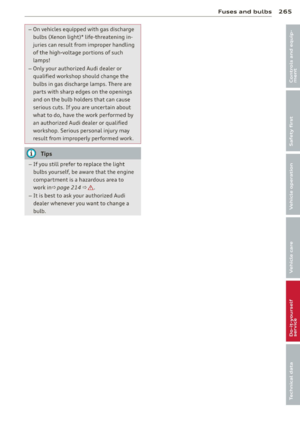 267
267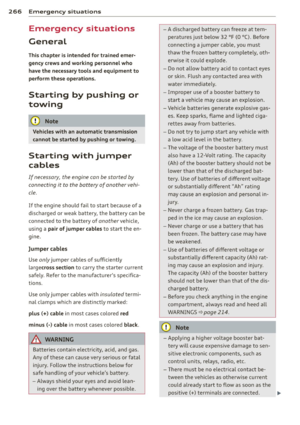 268
268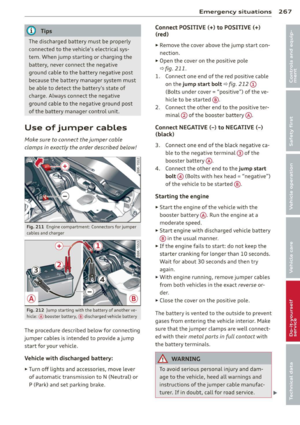 269
269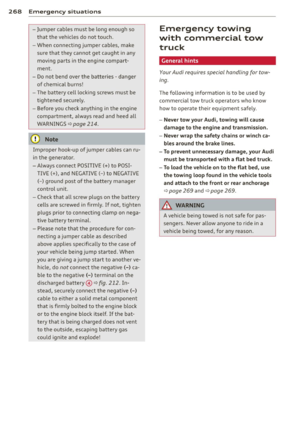 270
270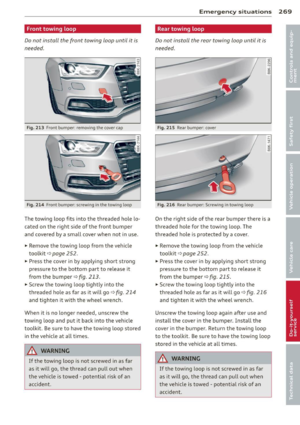 271
271 272
272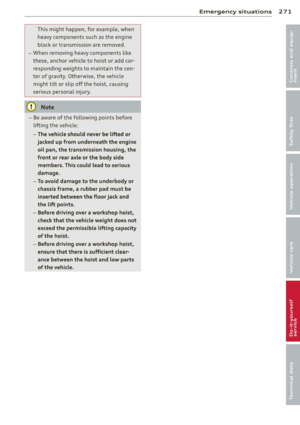 273
273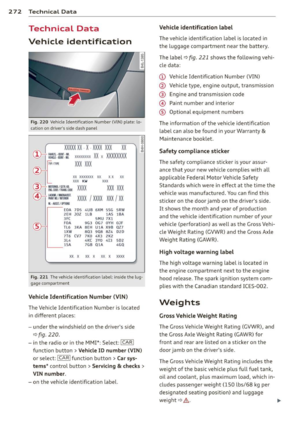 274
274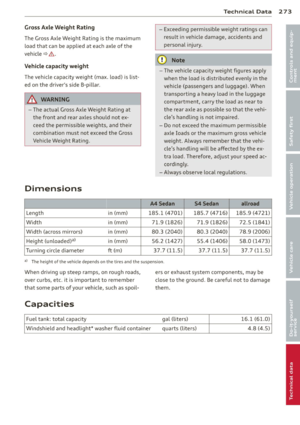 275
275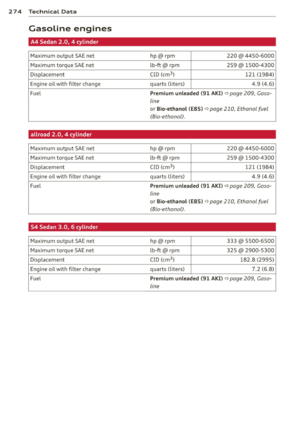 276
276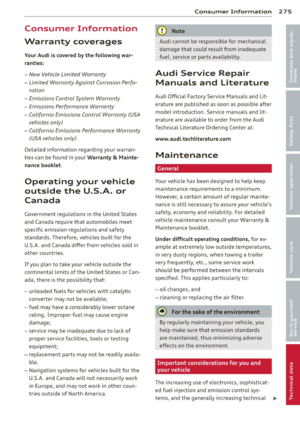 277
277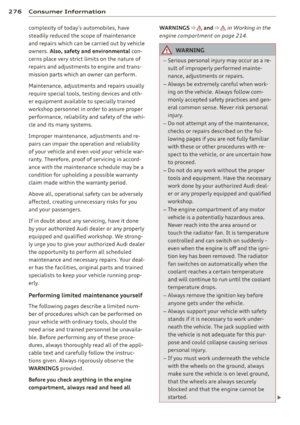 278
278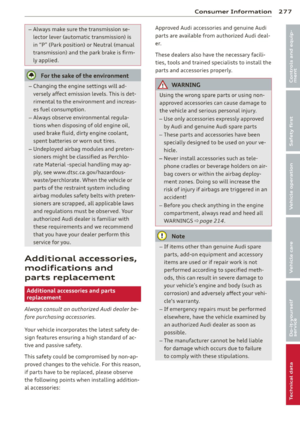 279
279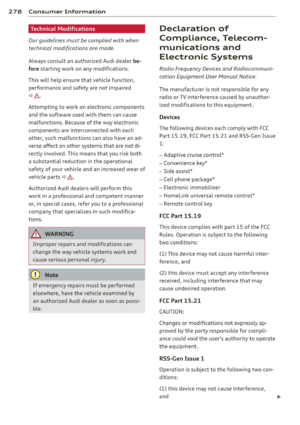 280
280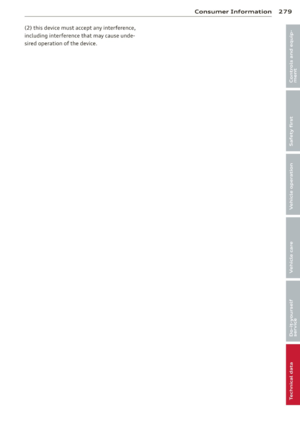 281
281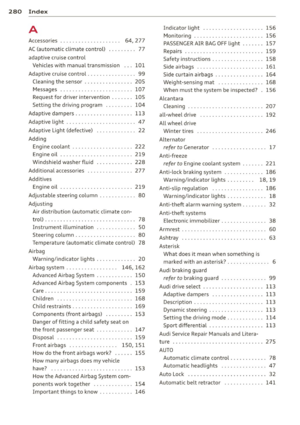 282
282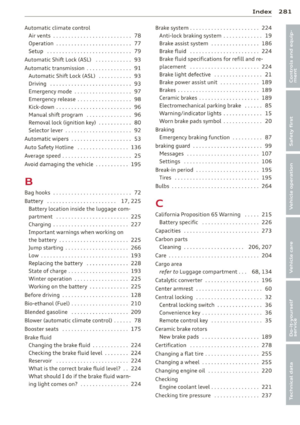 283
283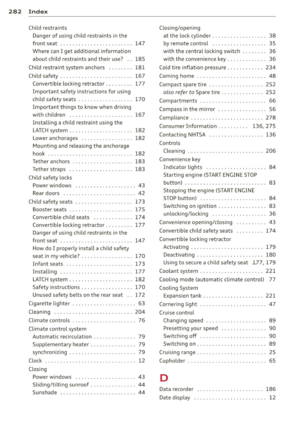 284
284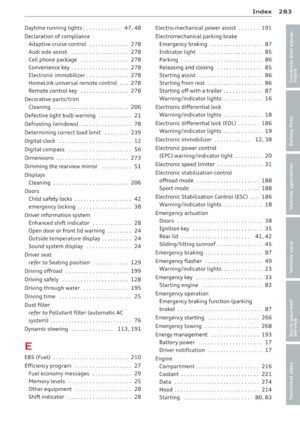 285
285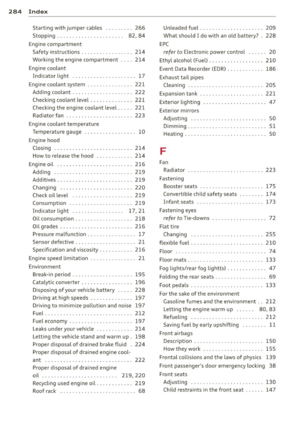 286
286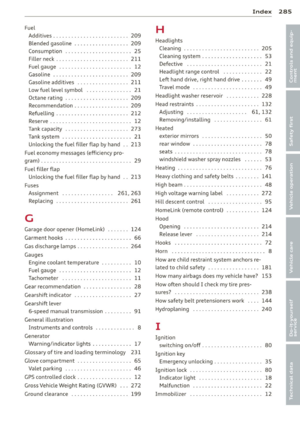 287
287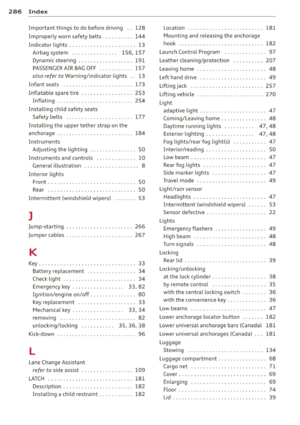 288
288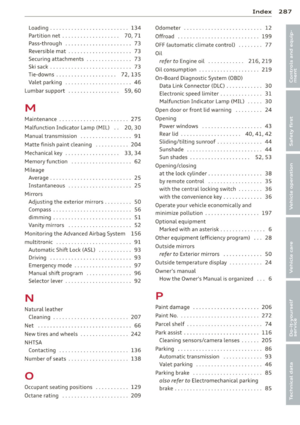 289
289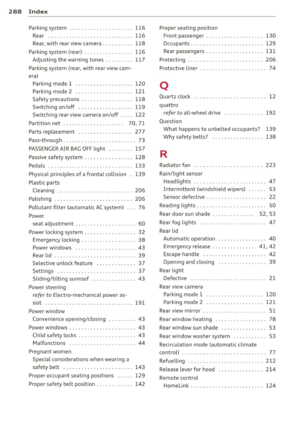 290
290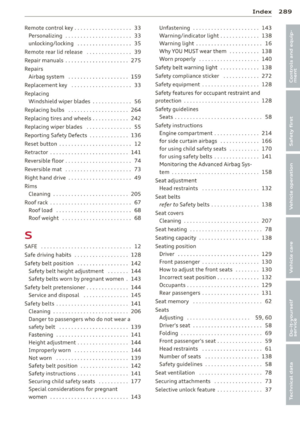 291
291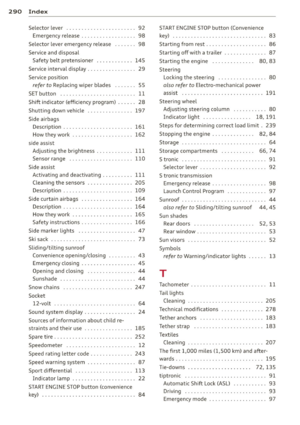 292
292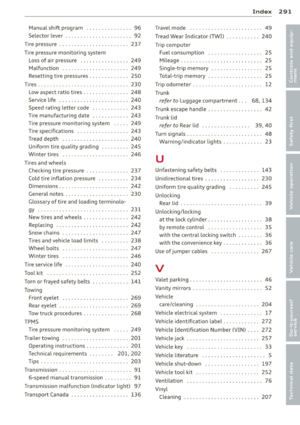 293
293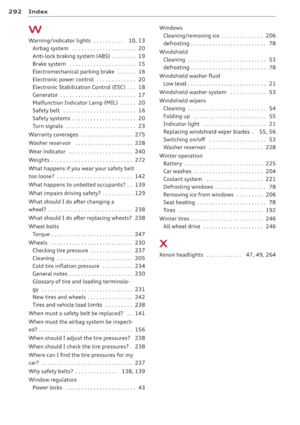 294
294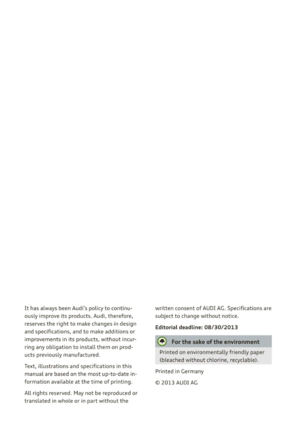 295
295






